It’s been a while since I’ve been this excited about a dessert, but once you try this phenomenal Vegan Lemon Cake, you’ll get it. It’s got that sweet-yet-tart zing you love in a good lemon dessert and it’s bursting with so much lemony flavor because this cake uses the entire lemon!
A mixture of aquafaba and vegan sour cream lends the most tender, moist crumb and a melt-in-your-mouth texture that is so good you might actually cry. It’s topped with a tart, not-too-sweet lemon cream cheese icing that is outrageously delicious.
It’s possibly the best cake I’ve ever made, and it is THE perfect cake to welcome spring, to celebrate birthdays, Mother’s Day, or anytime you’re in the mood for a special dessert.
Table of Contents:
1. Why this recipe works
2. Ingredients
3. Step-by-step instructions
4. Tips for making this recipe
5. Frequently asked questions
6. Video: How to make this cake
7. Recipe card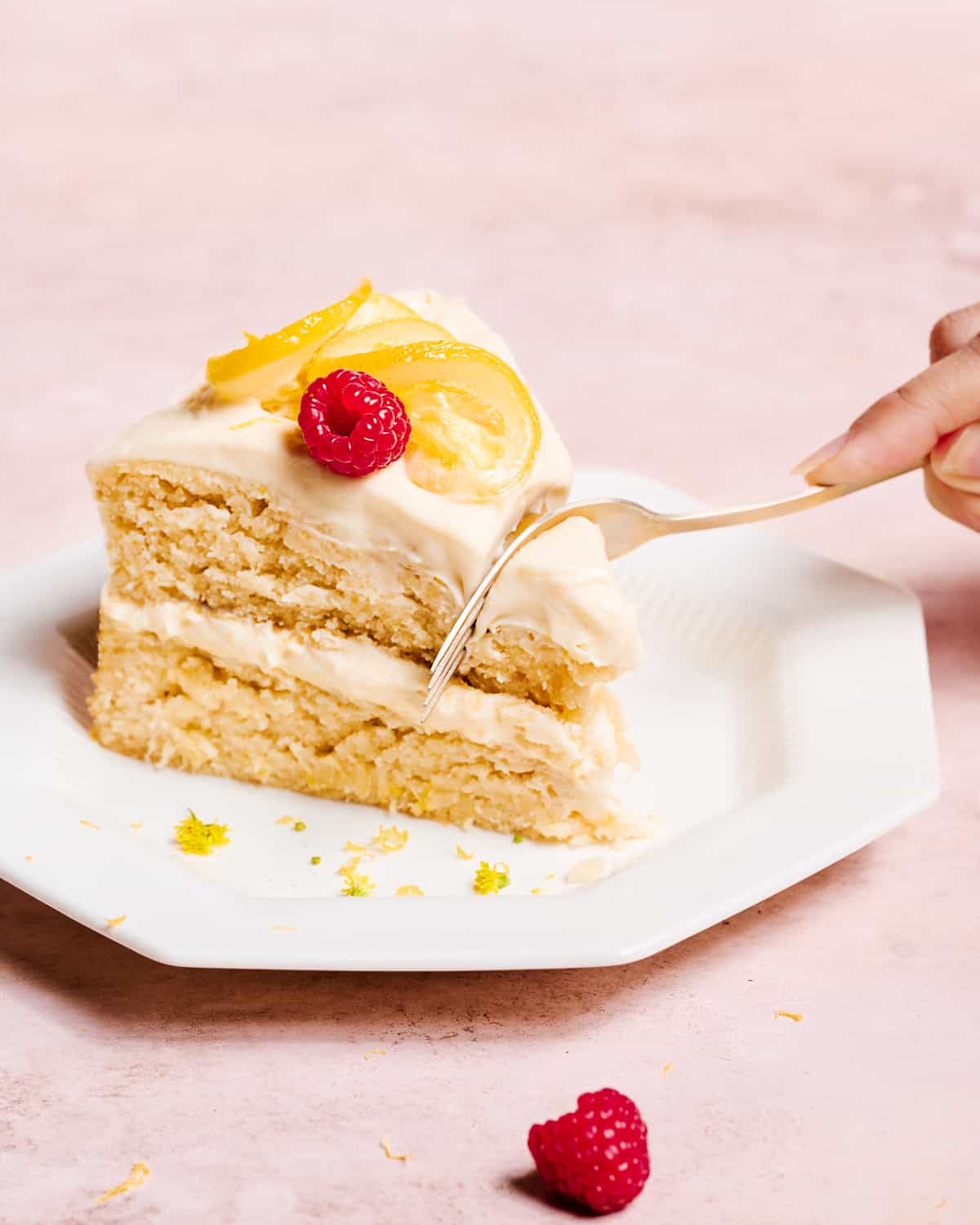
Why this recipe works
Made for lemon lovers.
The most disappointing thing about many lemon desserts is the mild lemon flavor, and many lemon cakes ditch lemon juice altogether and use lemon extract, but I wanted to bring the zingy flavor of real lemons to the table for this recipe.
The problem is that adding a lot of lemon juice can screw up the texture of cakes, especially vegan cakes. In our first few tests, we added ¾ cup lemon juice. The flavor was amazing, but the texture was gummy and dense.
This is because too much acid interrupts the development of gluten and can cause the cake to rise and then fall. Yet when we used less lemon juice, we could barely taste the lemon flavor.
Solution: Use other parts of the lemon! Lots of lemon zest gets rubbed into the sugar to release its essential oils. Minced pieces of whole lemon and just enough lemon juice are also added for that zippy tartness.
We use everything but the bitter white pith from the lemons. In reducing our food waste, we also cracked the code for the most amazing lemon flavor without compromising on texture.
The frosting brings even more lemon flavor to the mix. It’s tangy from cream cheese, tart and zingy from lemon zest and juice, not too sweet, and wildly good!
Melt-in-your mouth texture
Thanks to lightly whipped aquafaba and vegan sour cream, the cake boasts a light and fluffy texture that literally melts in your mouth. It’s so soft and moist that it makes you close your eyes. Yes, it’s that kind of cake.
Gourmet but approachable.
This cake is easy to make and features basic ingredients like lemons, flour, sugar, and vanilla, but it’s so gourmet your guests will think it came from a fancy bakery. Plus, it freezes fantastically so no leftovers will go to waste!
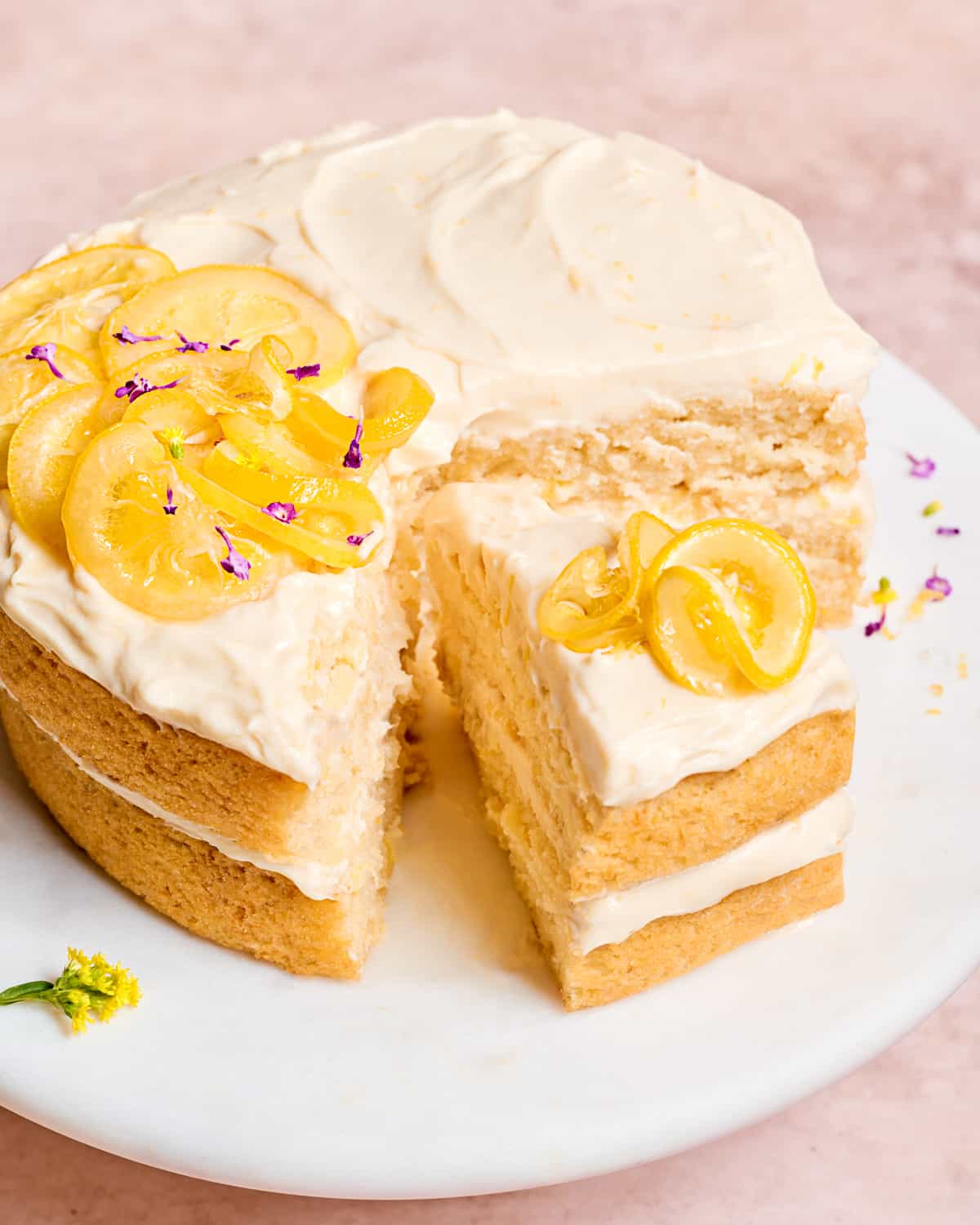
Ingredient notes
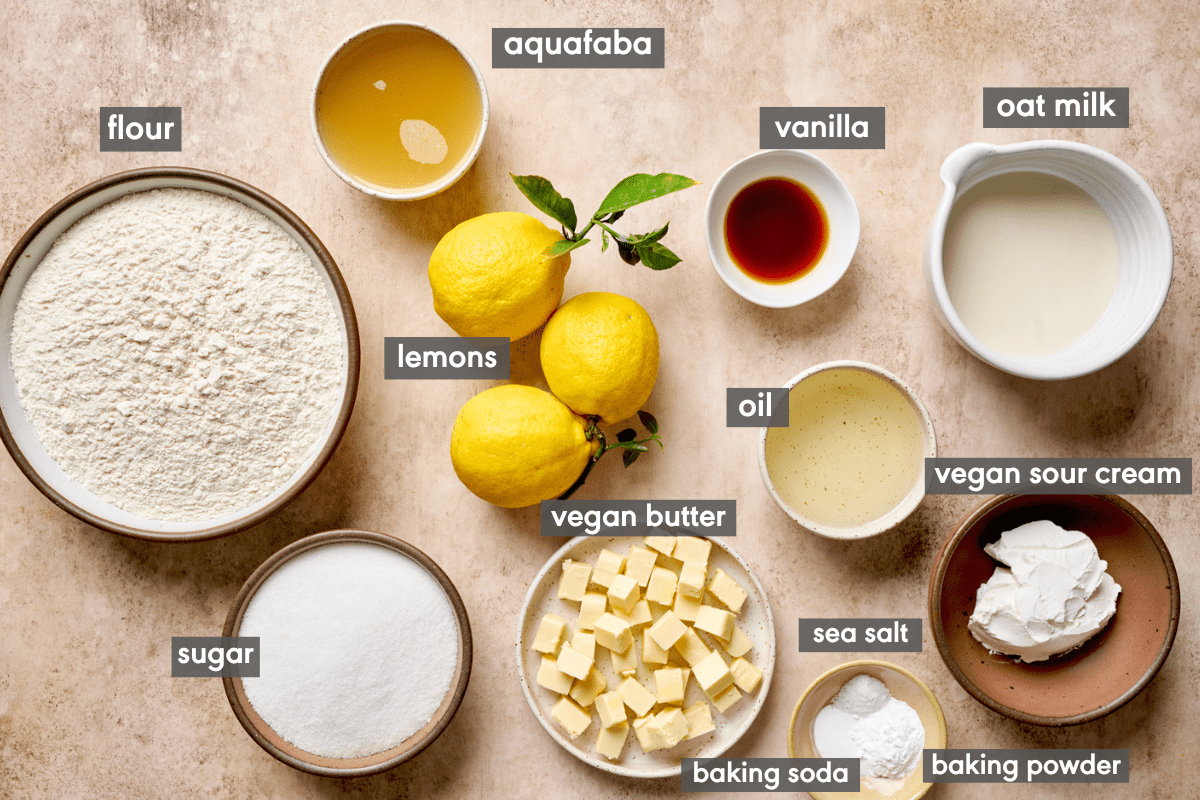
Lemons (the whole thing!)
I always recommend using freshly squeezed lemon juice in cooking and baking because the flavor from the plastic bottles doesn’t compare, but it’s even more crucial when lemon is a key ingredient, as in lemon cake.
Plus, you will need the zest and pieces of peeled lemon from fresh lemons. The zest adds its characteristic zippy floral notes, while the tiny pieces of lemon fruit add little bites of juicy and tart lemon flavor.
Vegan Sour Cream
This is one of the secrets to this vegan lemon cake’s fabulous texture.
We found that replacing ½ cup of plant milk with sour cream did wonders. It added rich flavor and moisture, plus a more tender crumb that practically melts in your mouth.
Tips for buying: We tested this recipe with two brands of vegan sour cream, Tofutti and Kite Hill with excellent results! Based on our experience with other recipes, we think Follow Your Heart sour cream would work great too.
Substitute: We recommend sour cream for the best flavor and texture. If you don’t have access to it, you can probably use a good-quality vegan yogurt. Our favorites are Culina and Cocojune.
Aquafaba
Just the liquid from a can of chickpeas. As you might have learned from my fluffy vegan banana bread and chewy, fudgy brownies, it’s a great egg substitute in baking. Aquafaba is one of the primary methods for getting this vegan lemon cake so tender and light without having to rely on cake flour.
All-purpose flour
Speaking of flour, just everyday all-purpose flour works.
Vegan Butter
Adds that rich buttery flavor and a hint of saltiness to balance the sweetness.
Substitute: If you don’t have access to vegan butter, you can just use more neutral-flavored oil. It won’t have the same flavor but the texture should not change too much.
Oat milk
Our preferred milk for most baked goods. In our experience, its neutral flavor and creamy texture work amazingly well, and the natural sugars in oats help brown baked goods more.
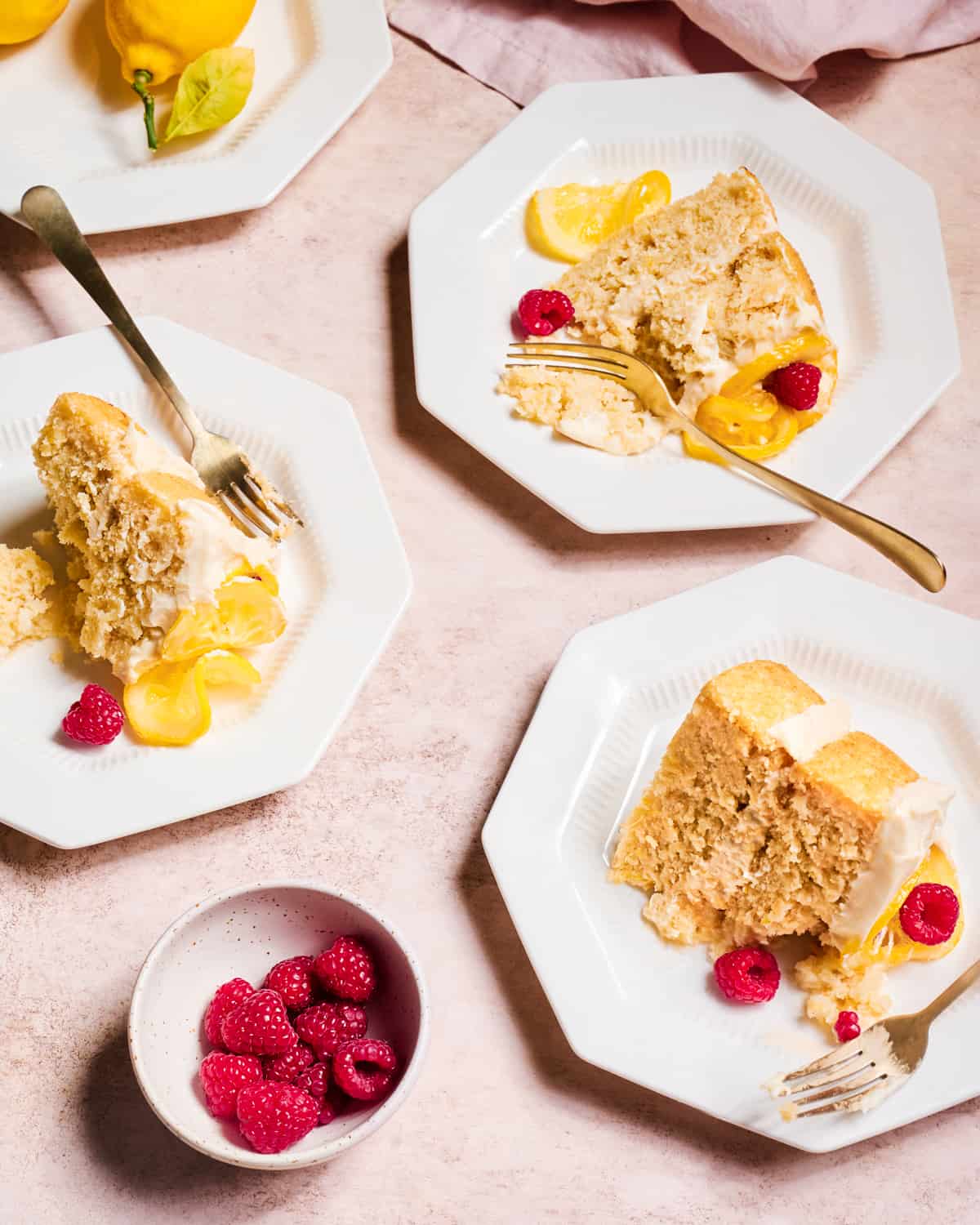
Step-by-step instructions
In a medium or large bowl, whisk together the flour, salt, baking powder, and baking soda.
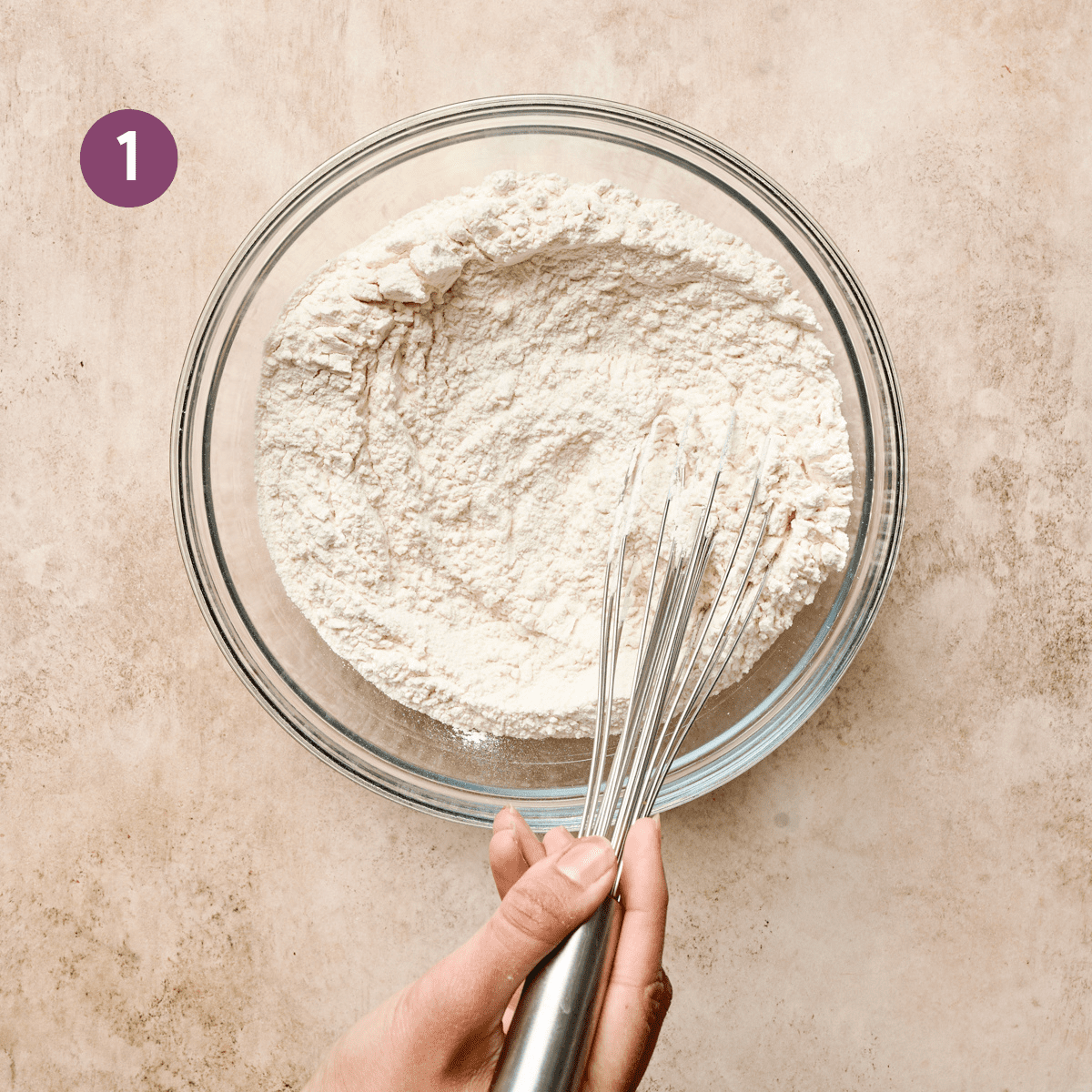
Zest the 3 lemons using a microplane.
Now use a knife to remove the lemon peels and white pith (image 2).
Remove the lemon segments out of the white membranes (see the white bowl in image 3). Mince the lemon pieces (see the bottom right corner of image 3) and pick out the seeds.
Transfer the lemon pieces and accumulated juices to a strainer set over a bowl. Measure out 3 tablespoons lemon juice and keep that with the lemon pieces.
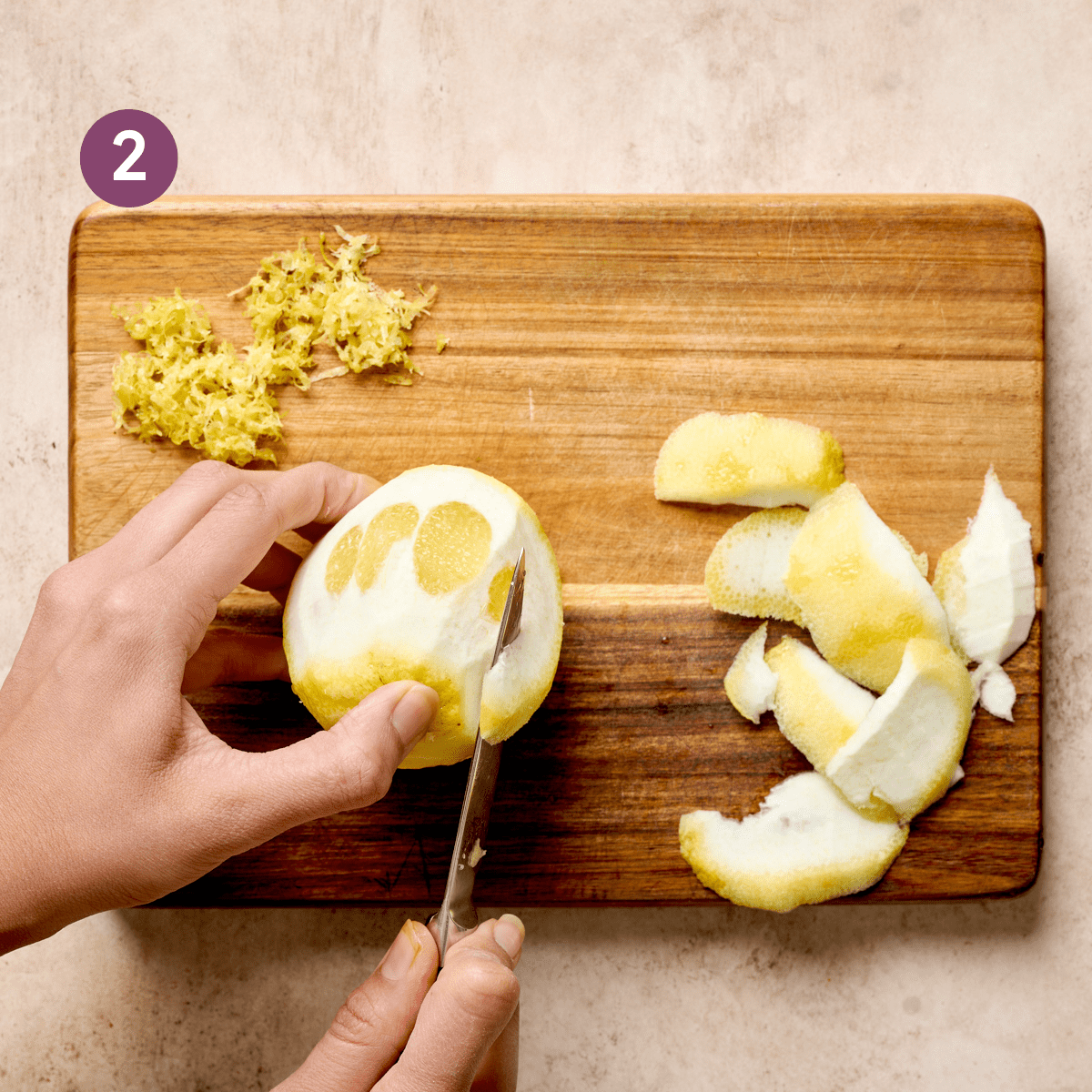
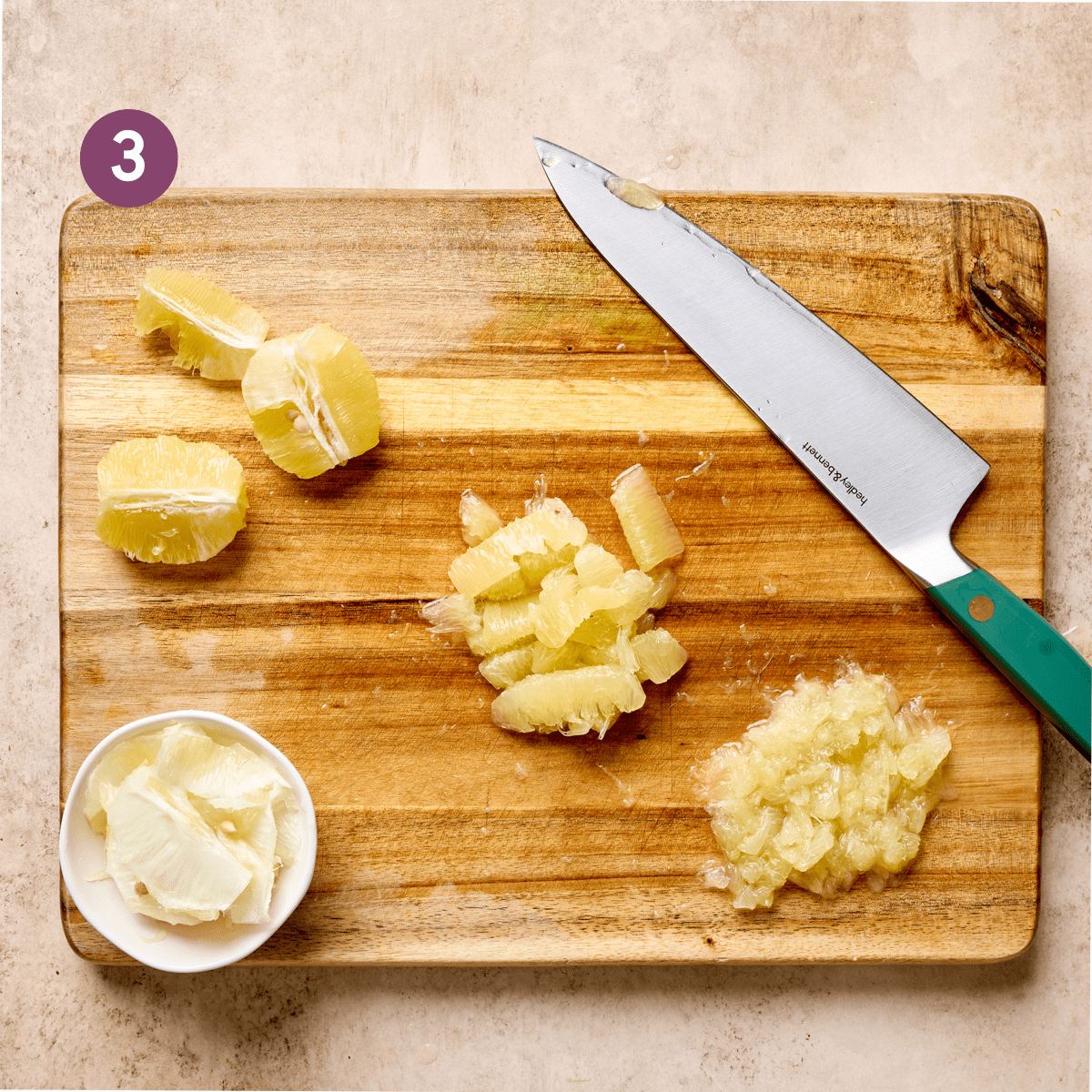
Add the sugar and lemon zest to a large bowl. Use your hands to massage the zest into the sugar until well incorporated and soft. Set aside.
In a small bowl, add the aquafaba. Whip on medium speed until foamy throughout.
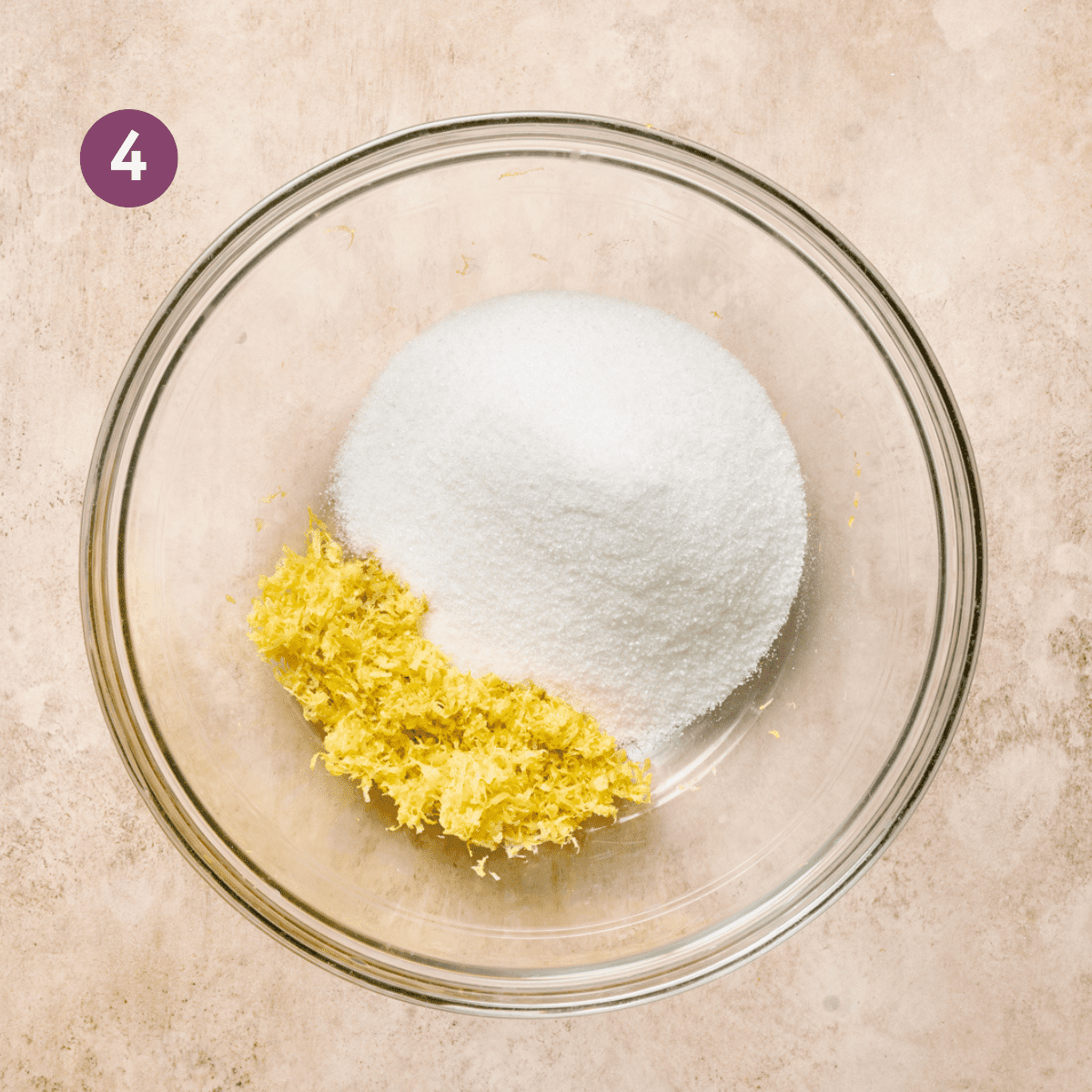
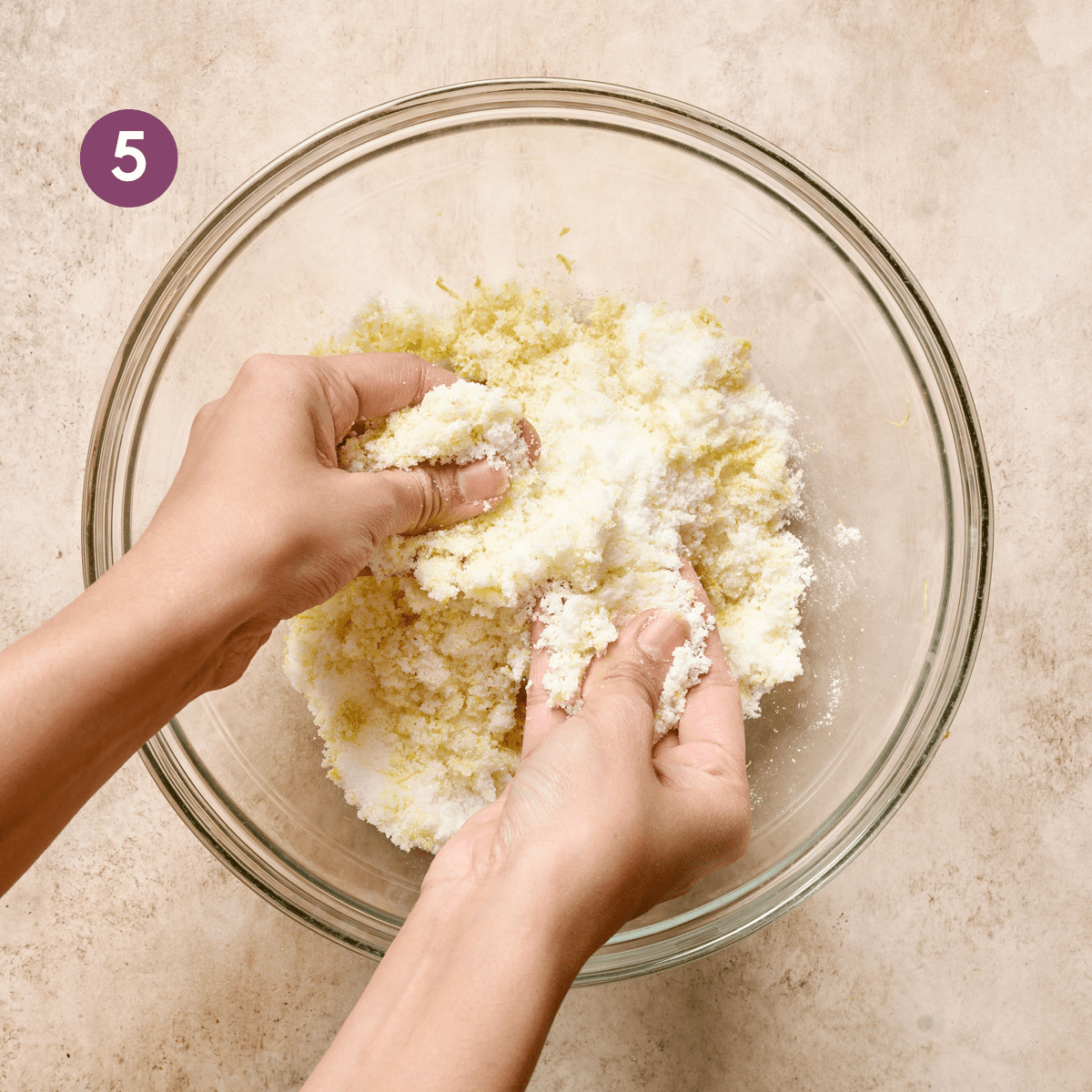
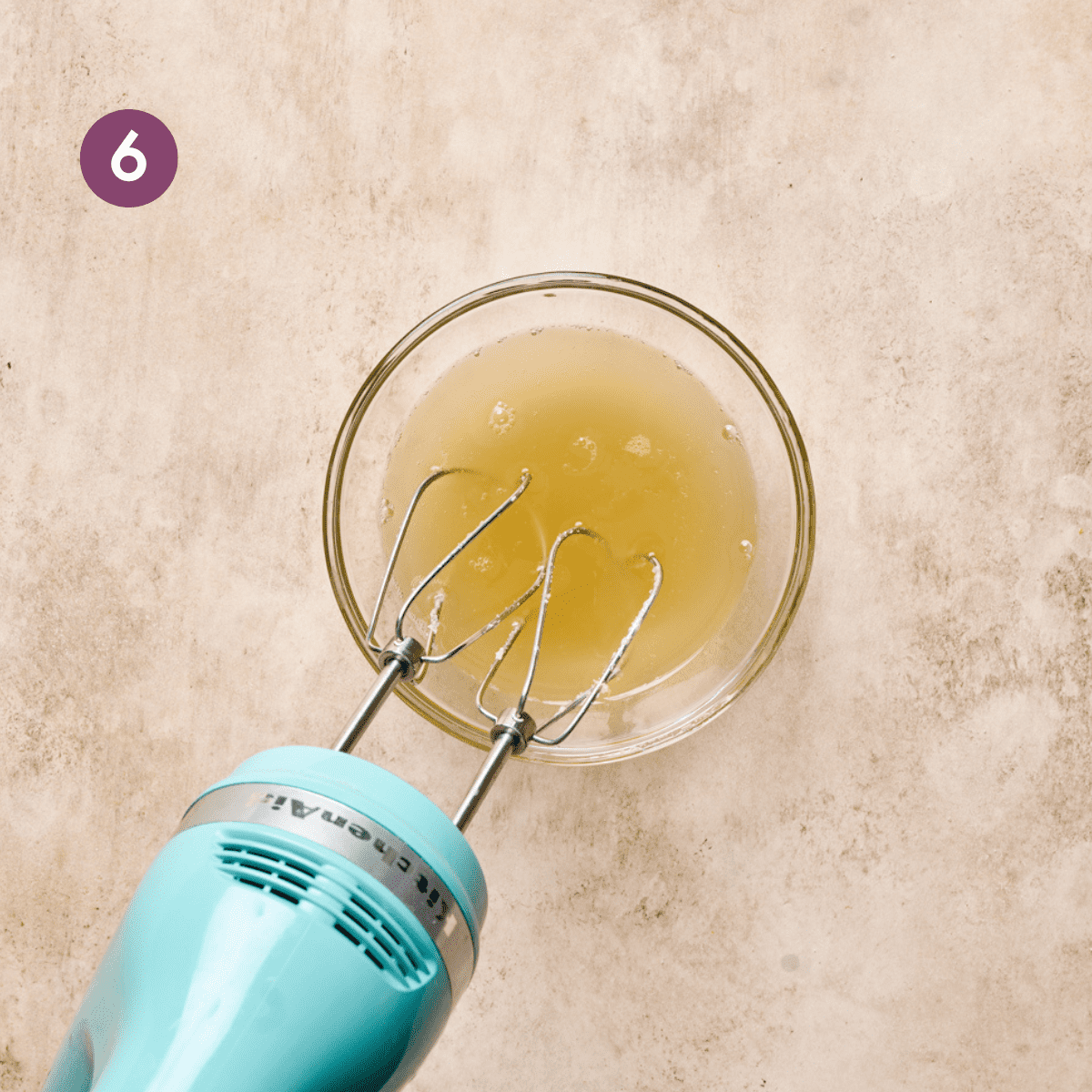
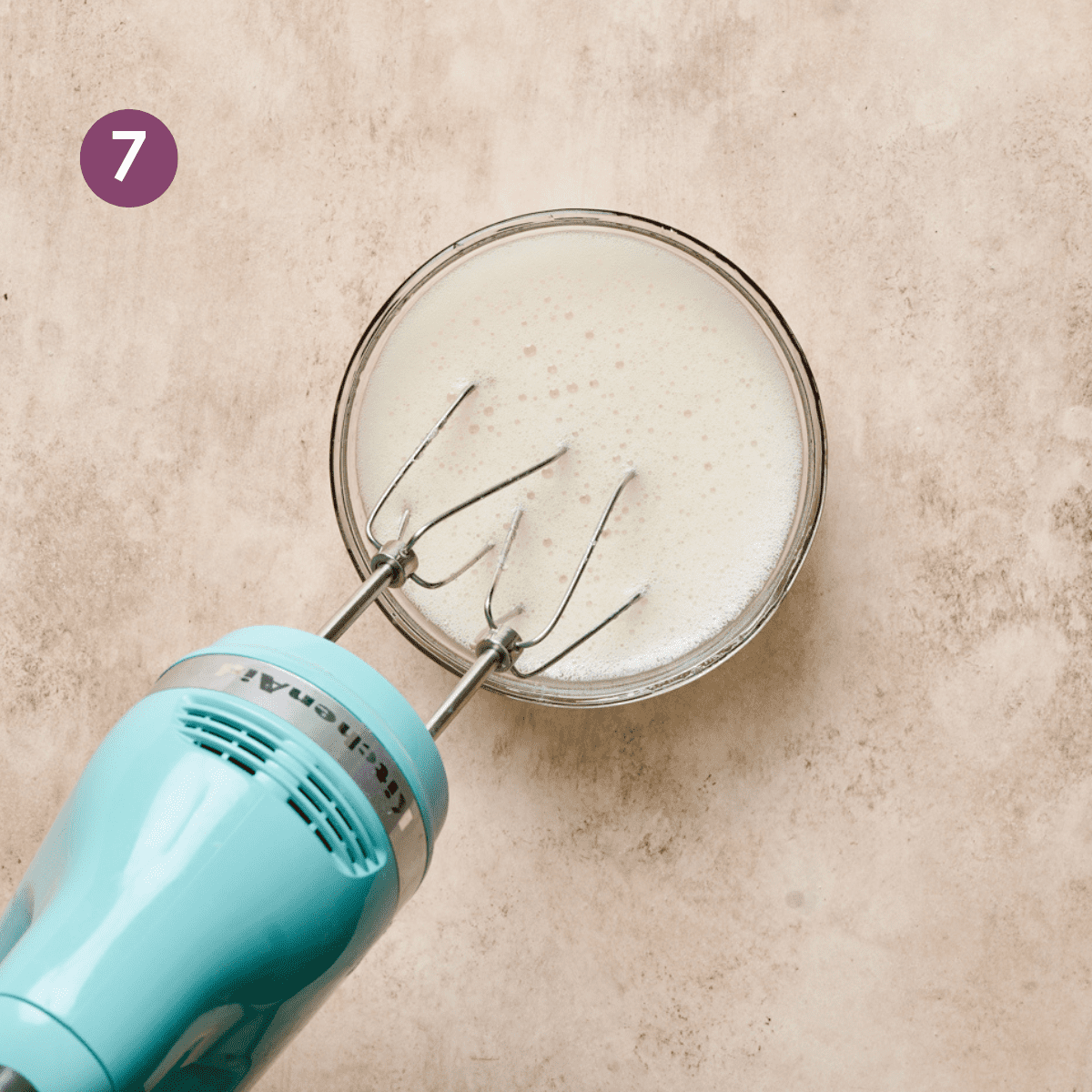
Add the softened vegan butter and oil to the lemon zest-sugar bowl. Beat until starting to get fluffy and glossy, about 1 minute.
To the butter mixture, add the whipped aquafaba, vegan sour cream, milk, and vanilla. Mix on low until just combined. Finally add the lemon pieces and juice.
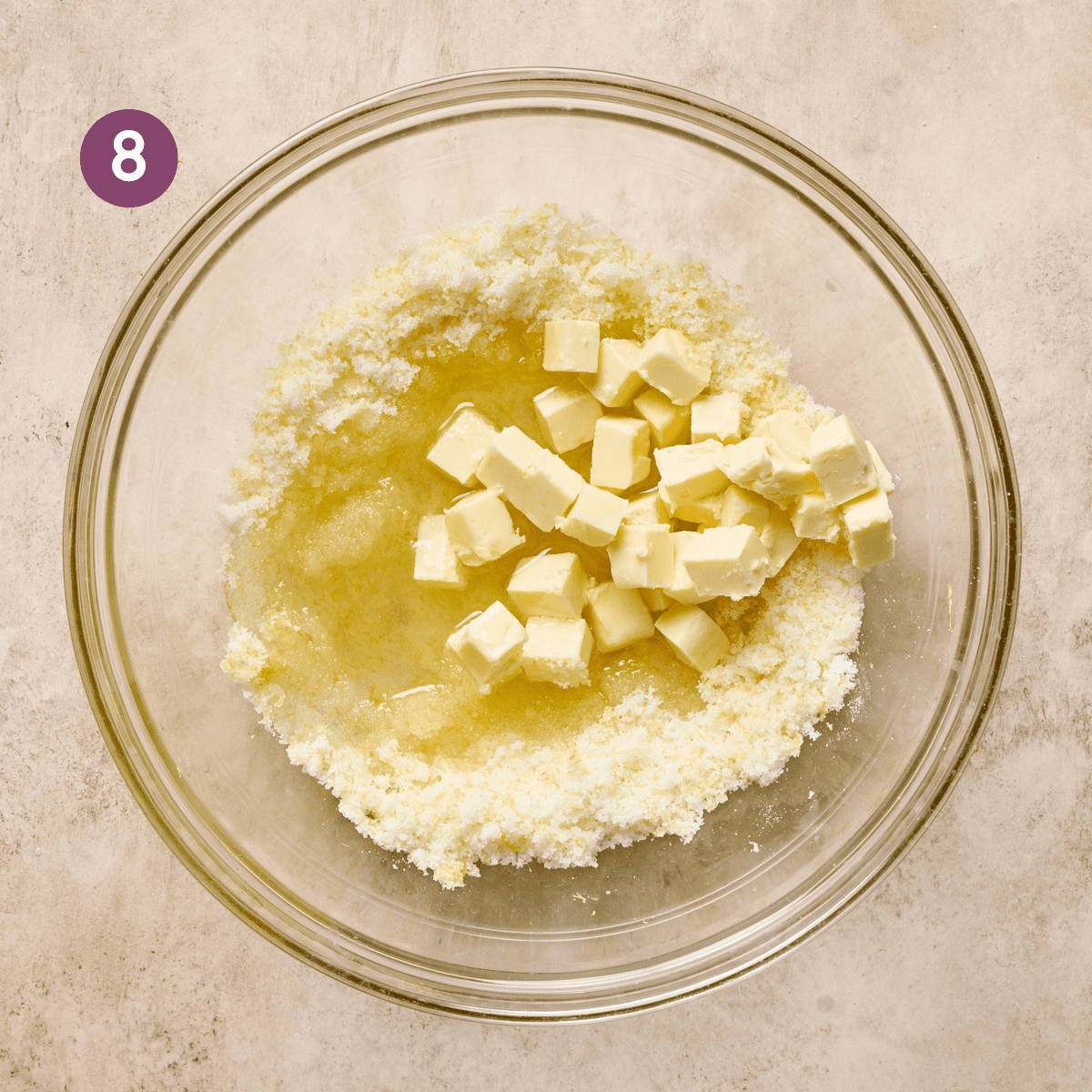
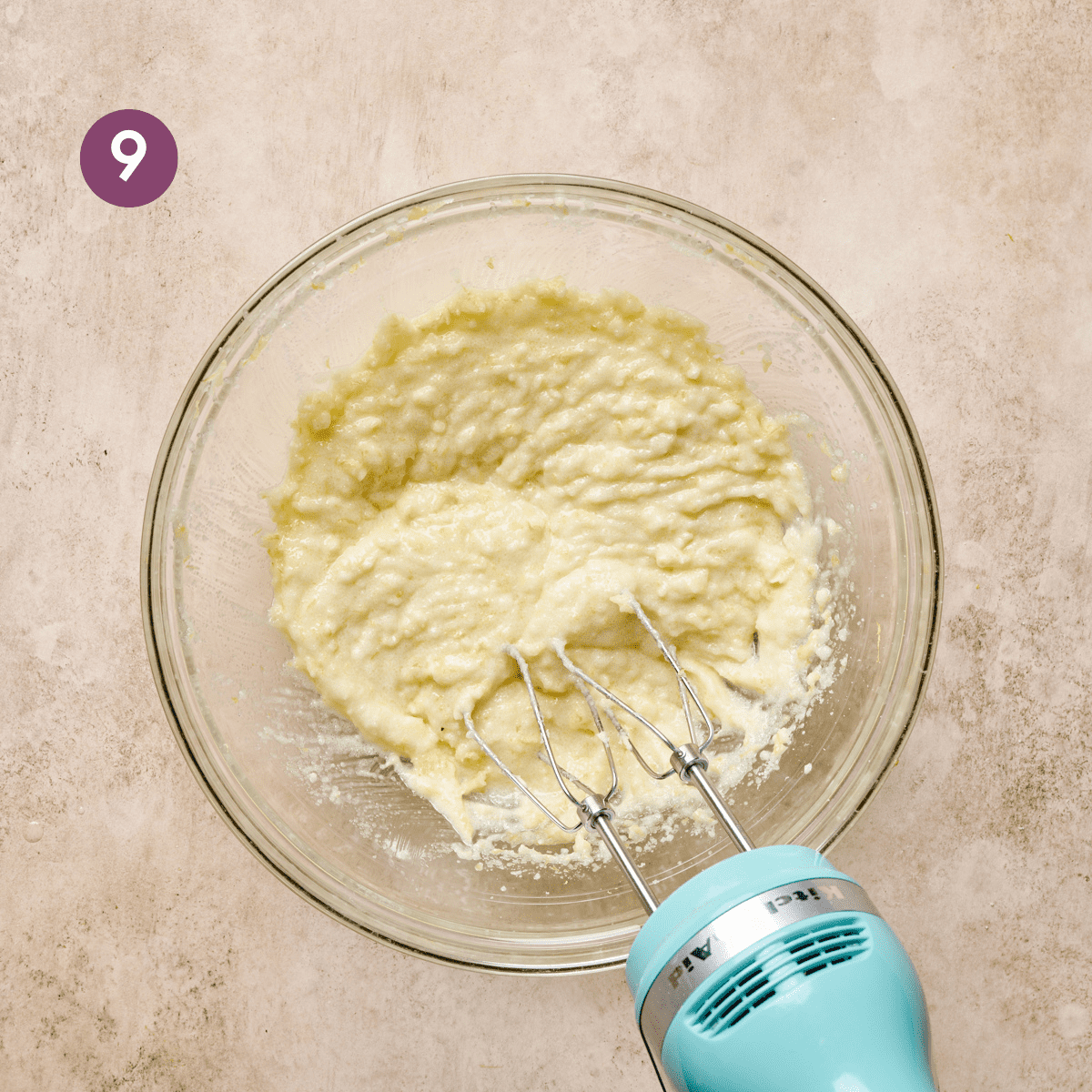
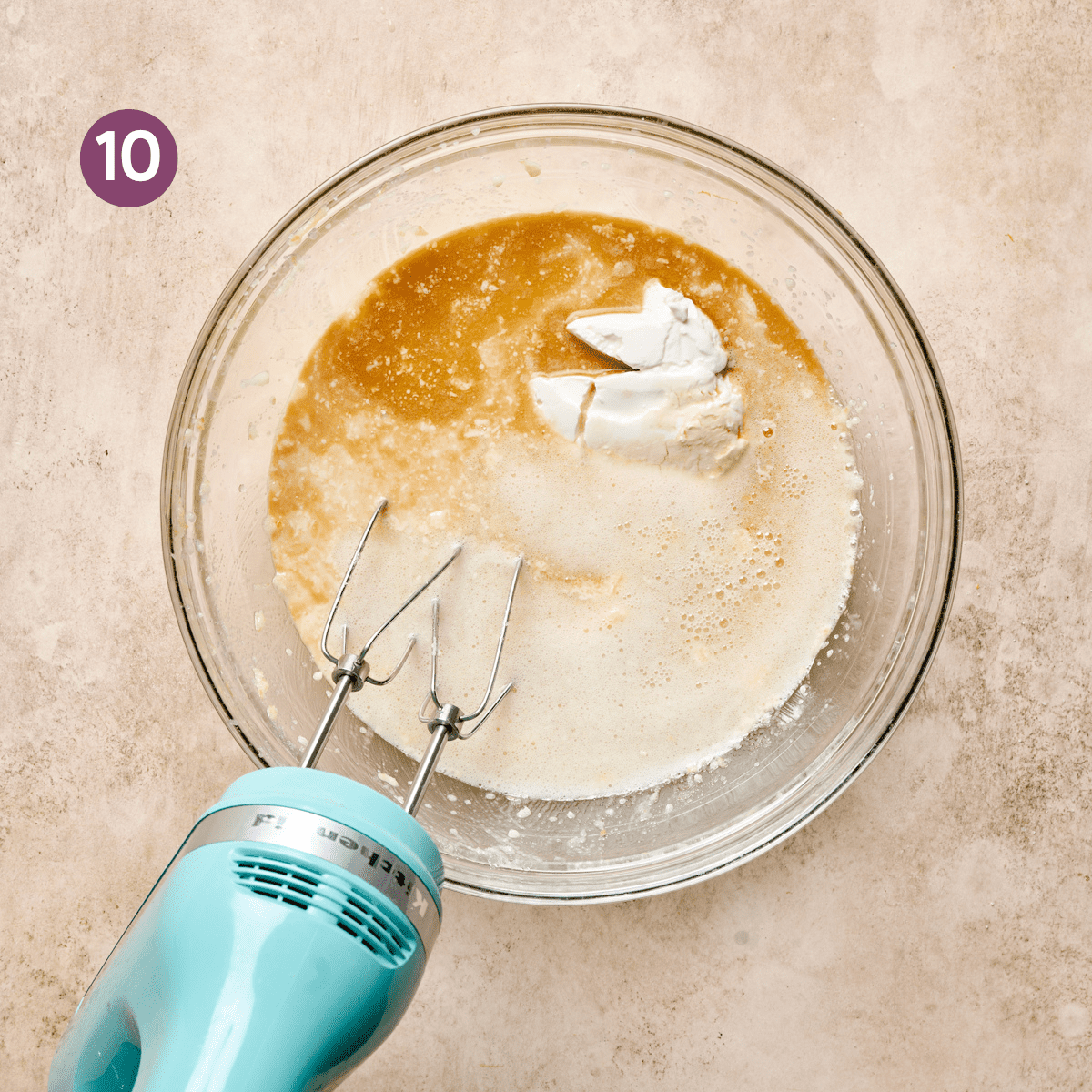
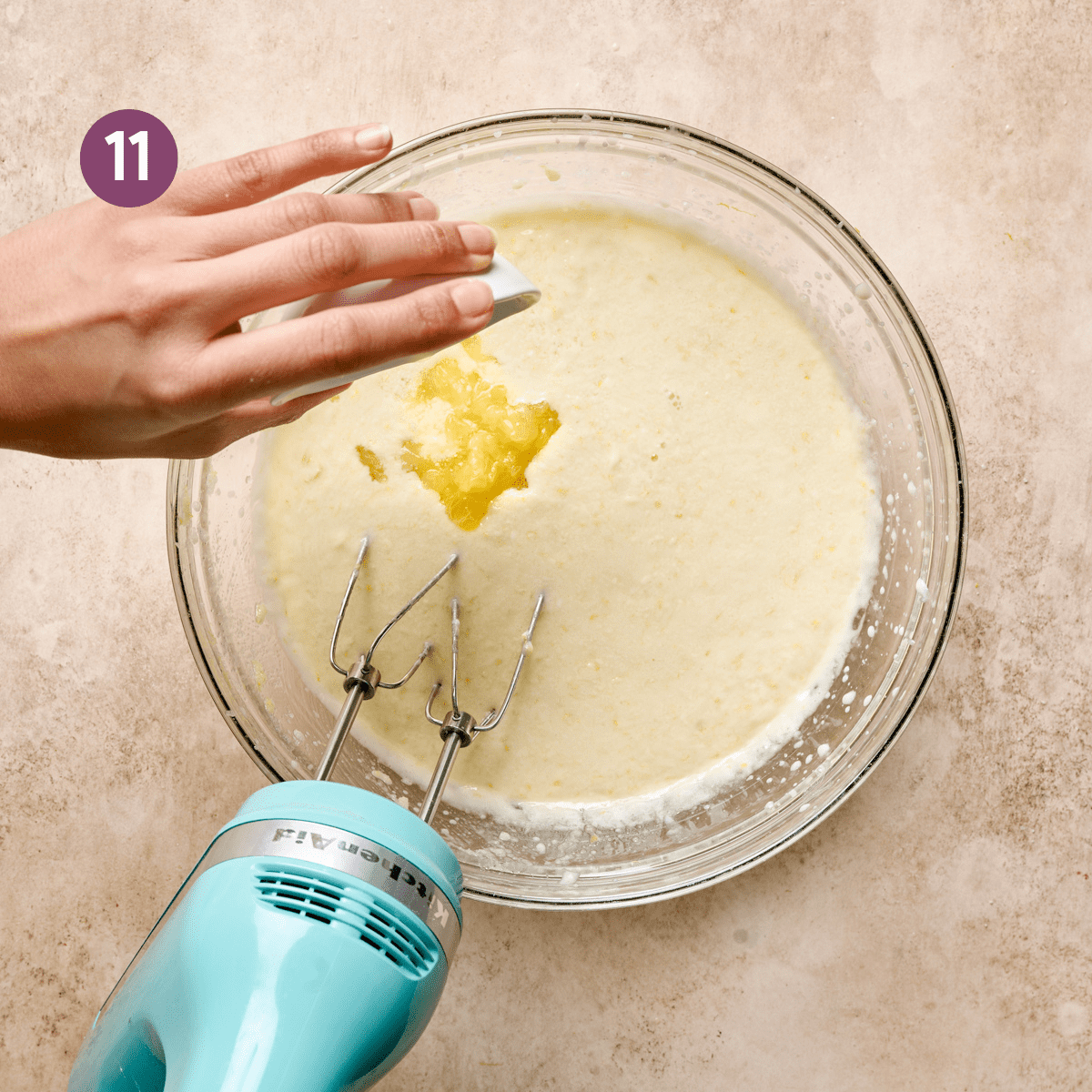
Mix again until the mixture is well blended. Add in half of the dry ingredients. Mix on low until just combined.
Use a silicone spatula to fold in the rest of the dry ingredients, taking care to not over mix. The batter should be fluffy and thick but airy.
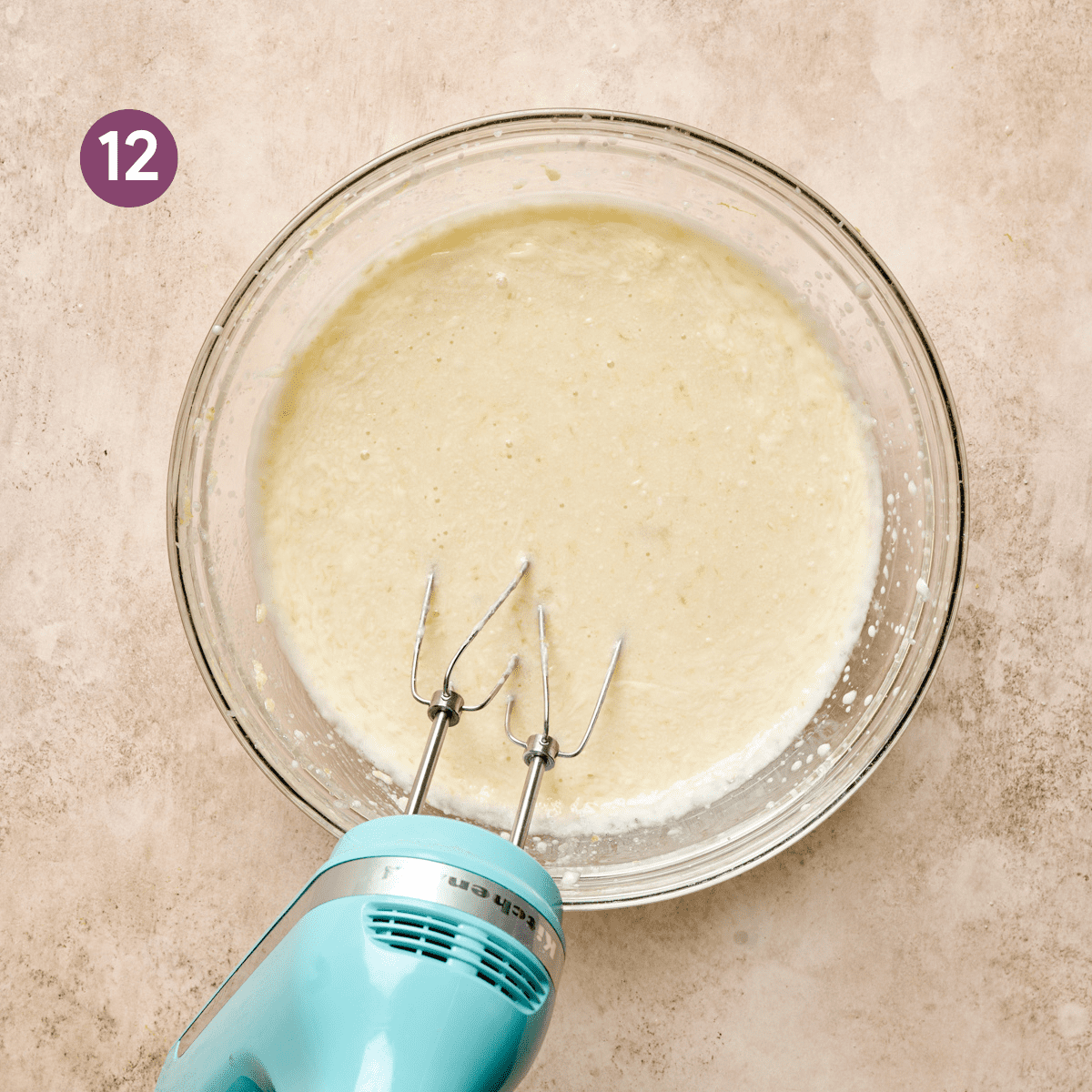
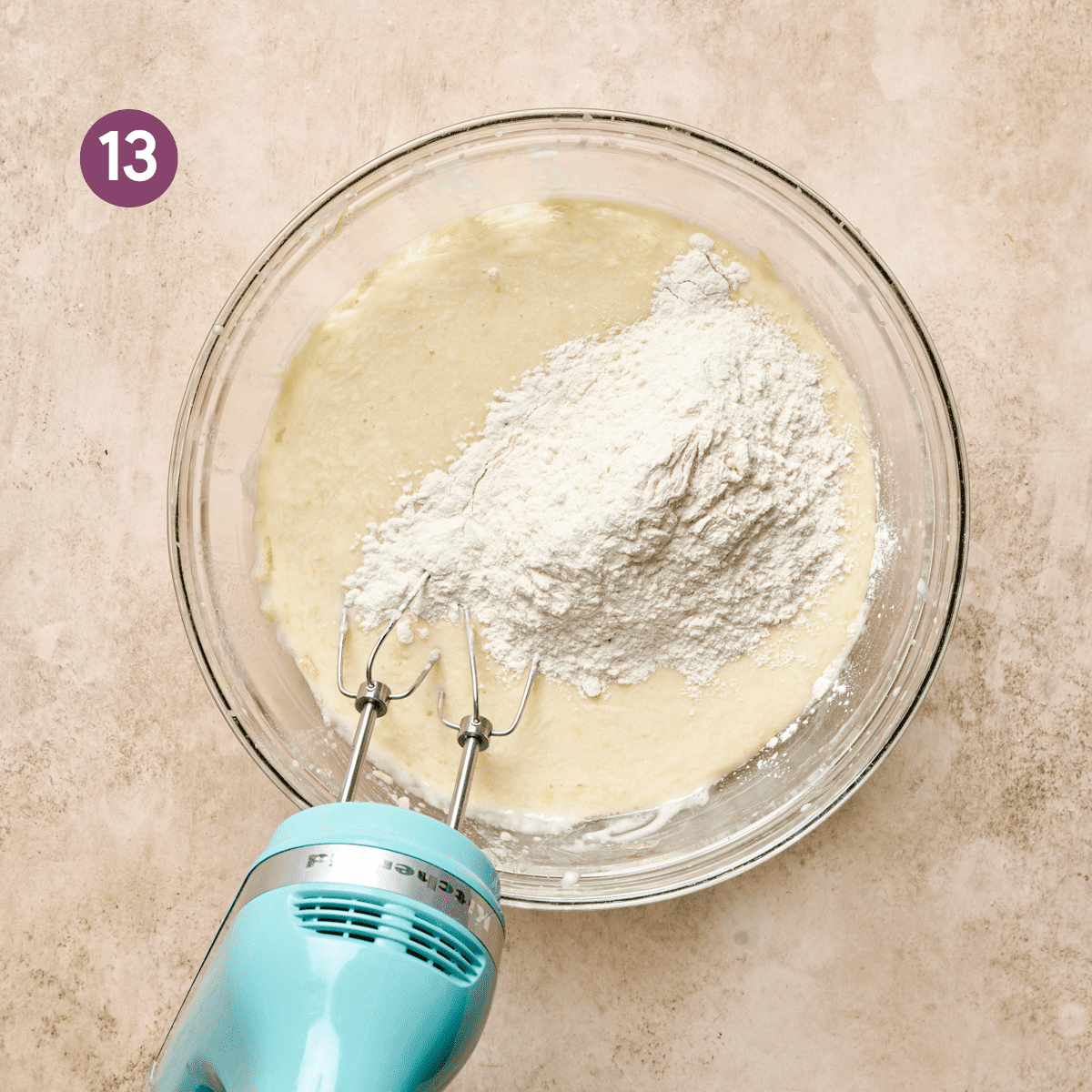
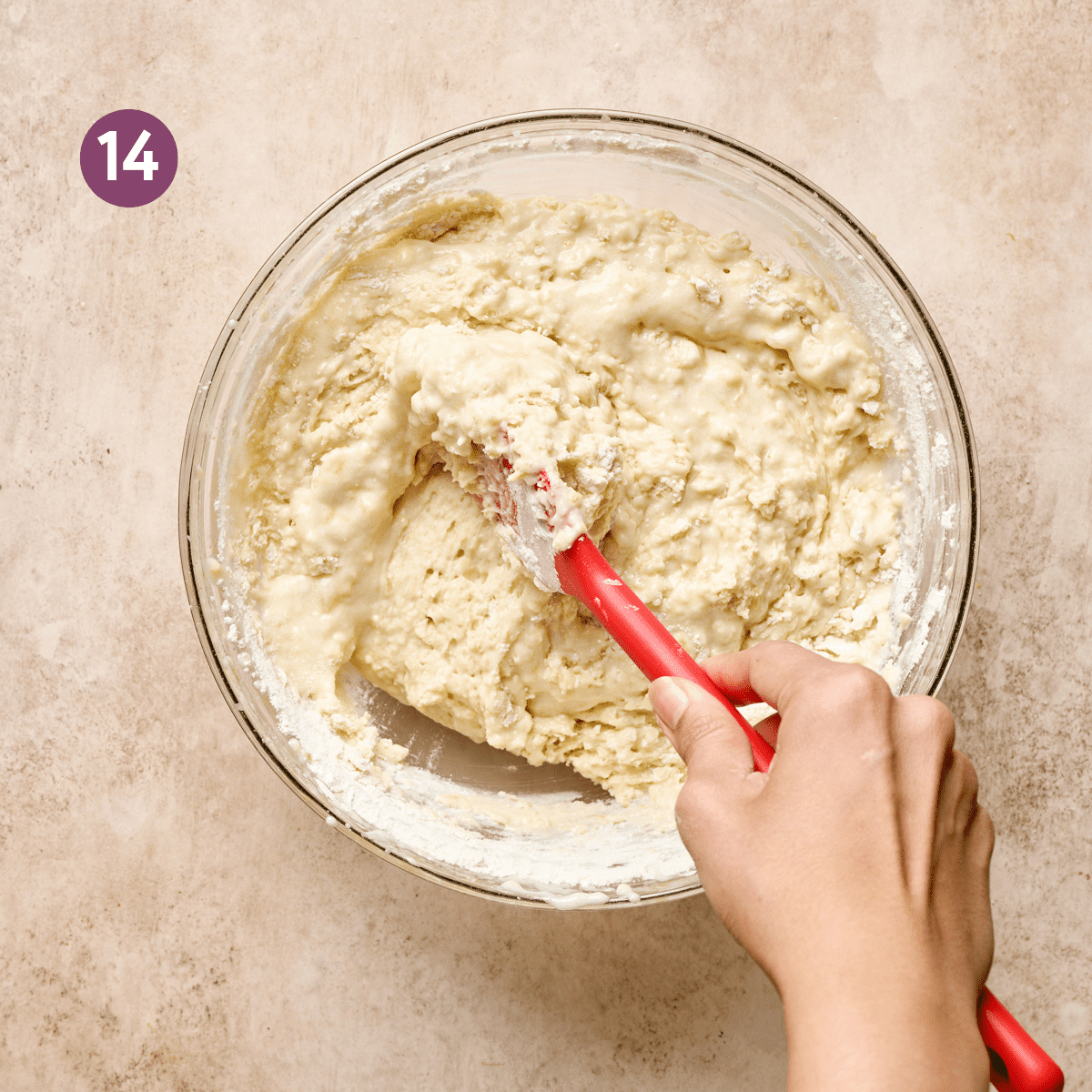
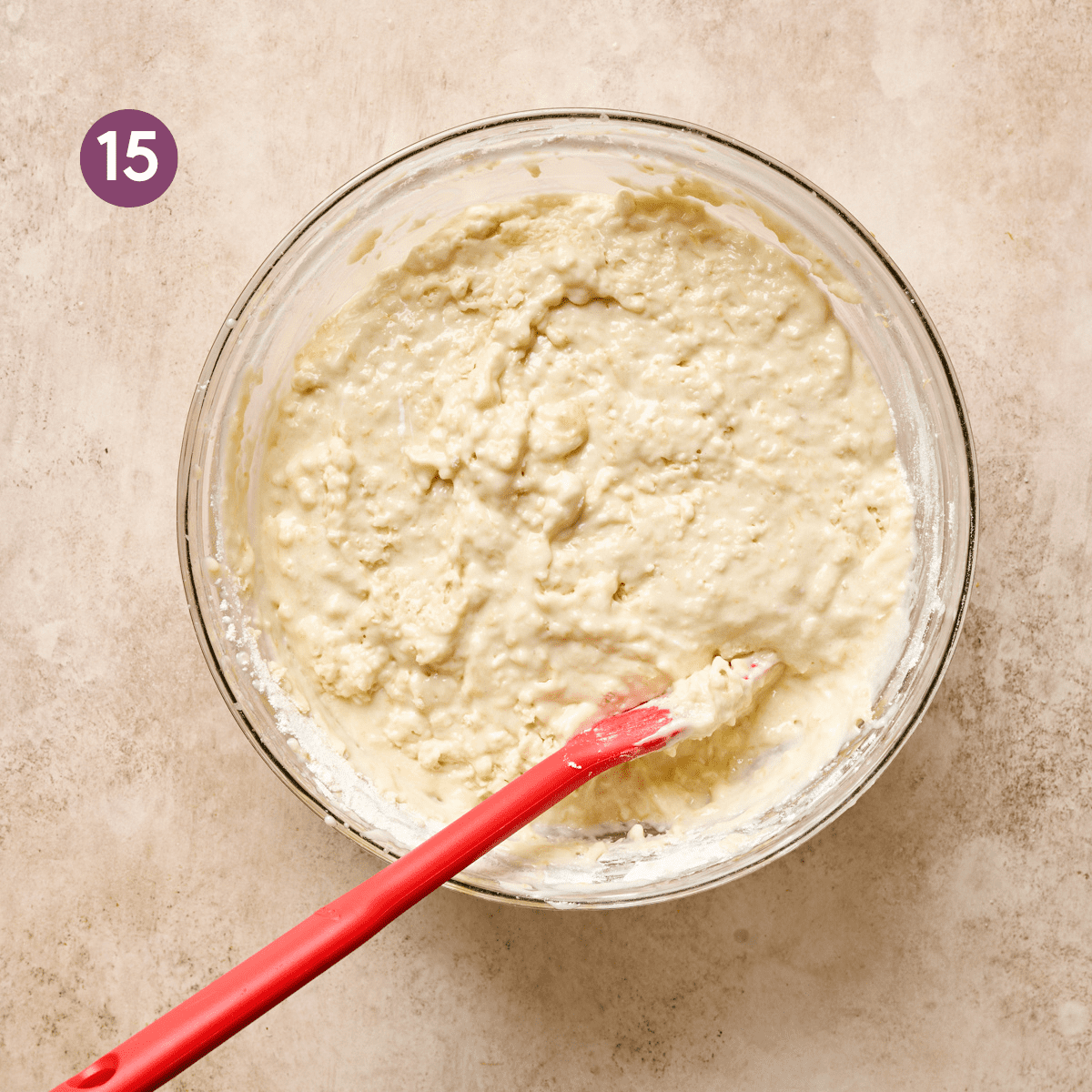
Divide the cake batter between two (8-inch) round cake pans that have been lined and greased.
Bake in the oven at 350ºF/175ºC for 30 minutes. Allow cakes to fully cool on a wire rack. Refrigerate to make it easier to frost.
Once fully cooled, frost the cakes with the Lemon Cream Cheese Frosting.
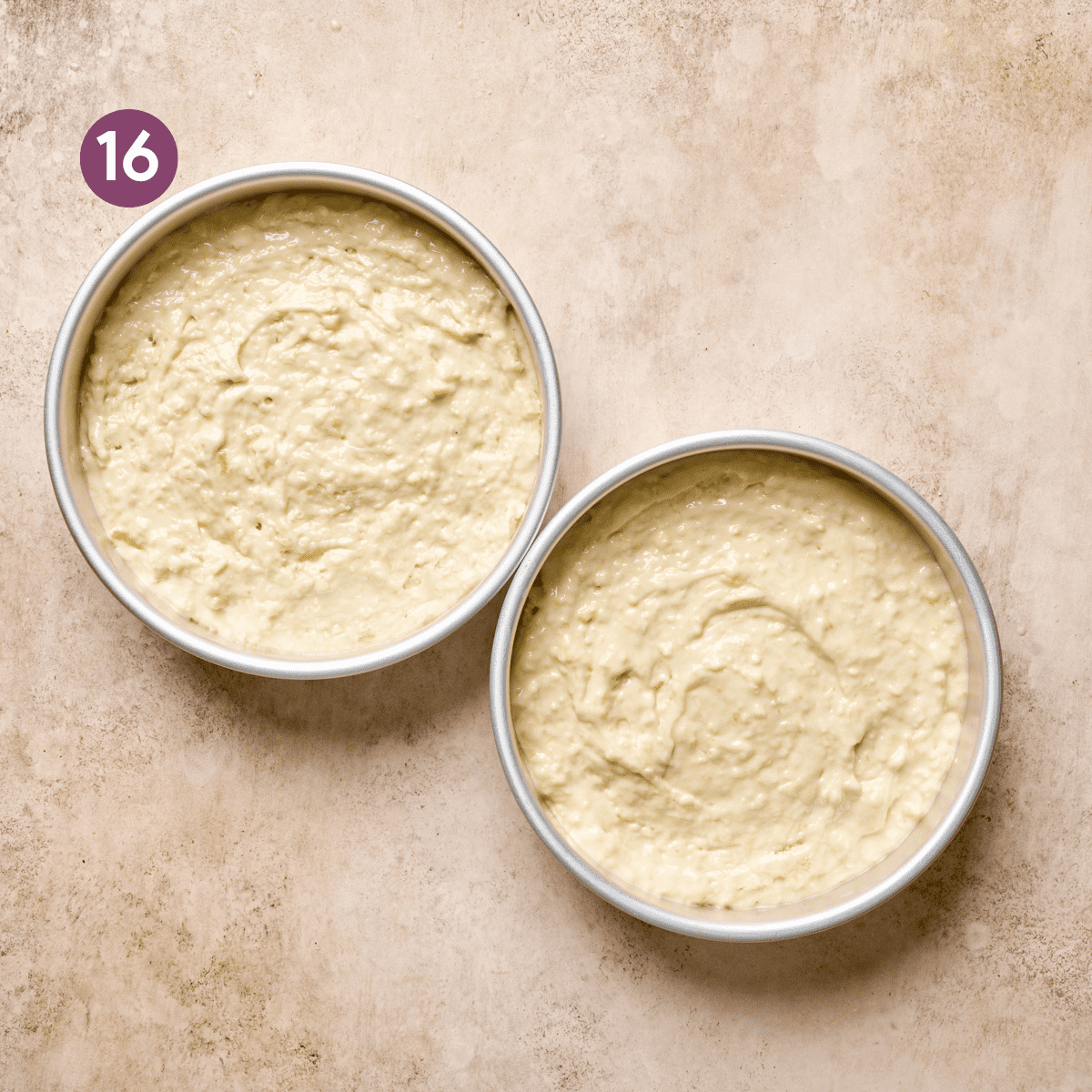
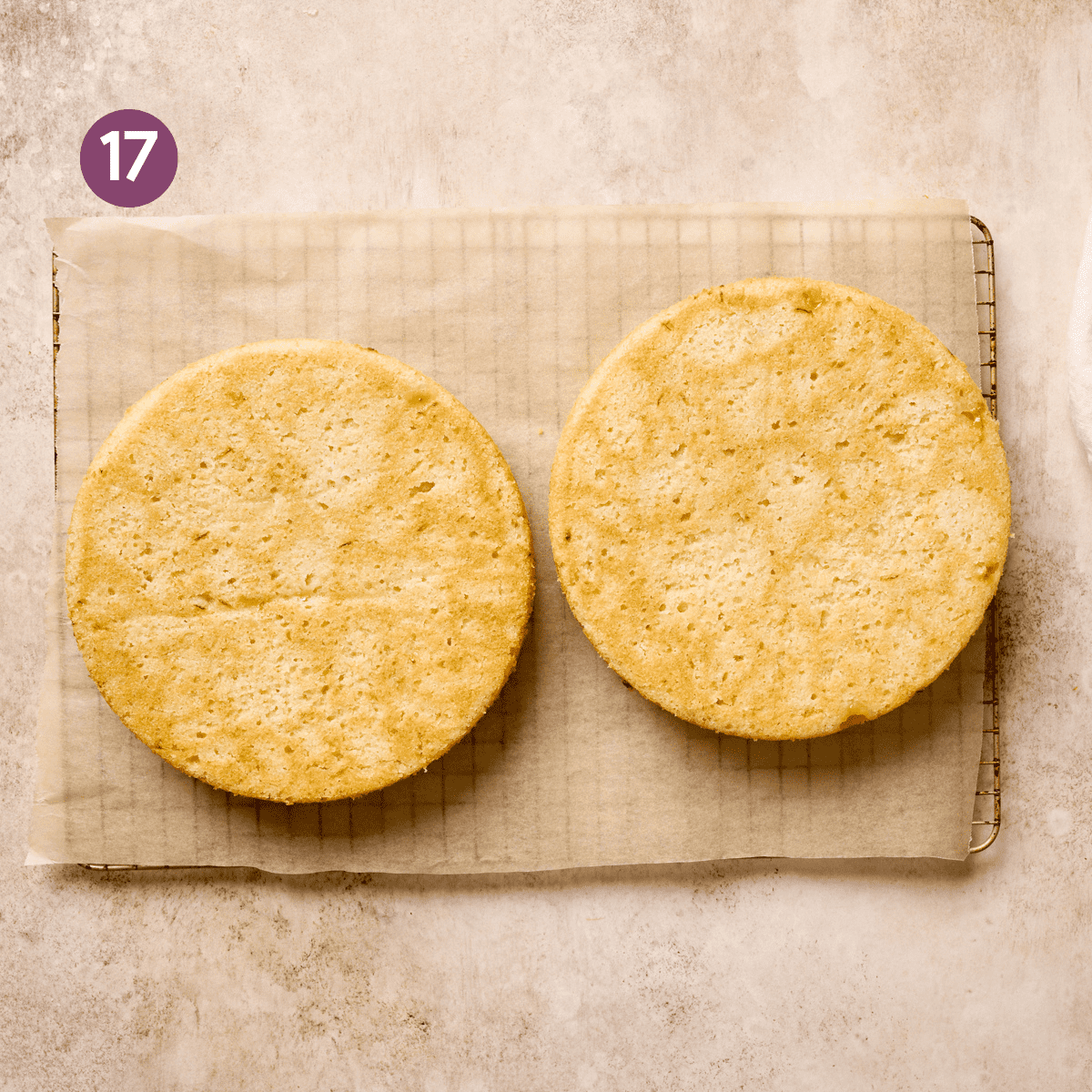
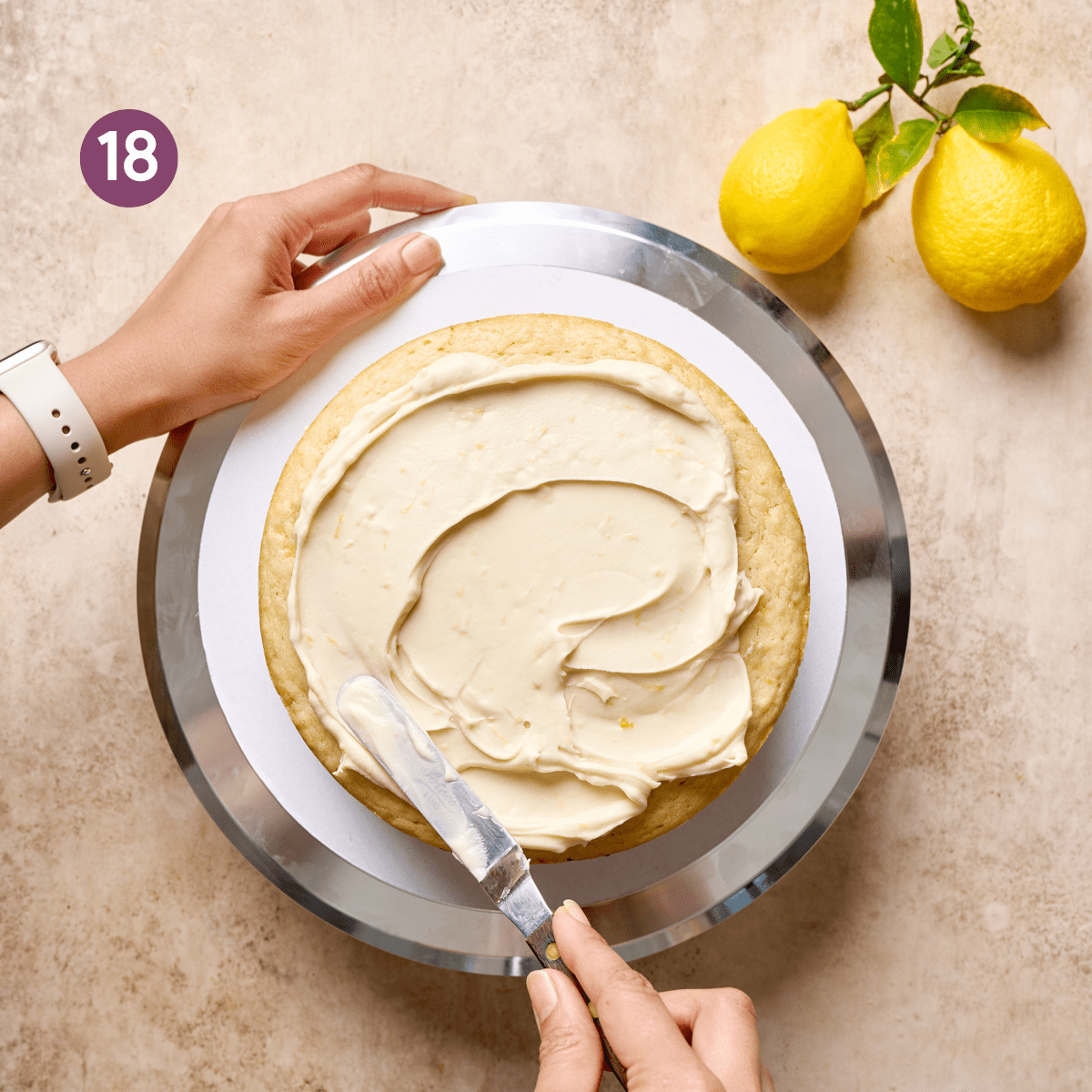
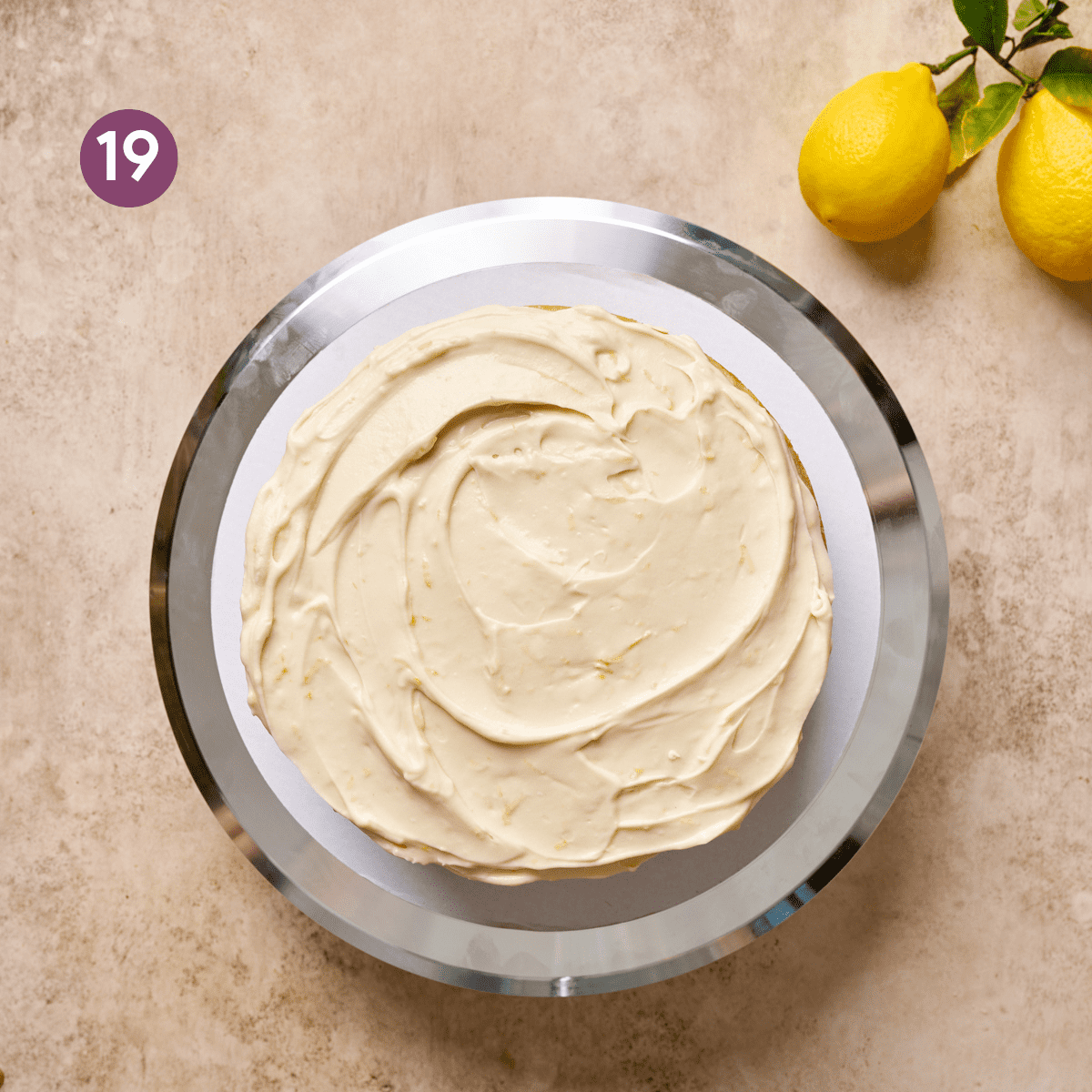
Tips for making this recipe
Measure precisely!
You probably know this by now, but I’m a huge advocate for using a kitchen scale, especially for all baking purposes! It yields the most exact results and makes less of a mess as a bonus!
If you don’t have a scale yet, be sure to use the spoon-and-level method when measuring flour. This prevents over-measuring flour, which can skew the final results in baking.
Spoon your flour from the bag/jar into a measuring cup until full. Do not pack it down as you spoon it in. Then use a butter knife to level it off.
Room temperature ingredients
Allow the milk, sour cream and butter to come to room temperature. When combining these ingredients together, room temp ingredients bond together very easily since they’re warmer, creating an evenly textured batter.
Doing this results in a beautiful fluffy and airy cake. Don’t skip this step or you’ll end up with a lumpy batter that doesn’t bake as nicely.
Prep everything before mixing.
Before combining the dry and wet ingredients, ensure everything else is ready (oven is preheated, cake pans are prepared). This is because the baking soda will start to leaven as soon as it’s mixed with the wet ingredients, so you want to capitalize on this leavening action.
Use a gentle touch when mixing.
First, add the dry ingredients to the wet ingredients in two stages.
During the first mix, the dry ingredients get coated with some fat but not too much liquid, helping to weaken the gluten bonds (which leads to tenderness). During the second mix, the rest of the liquid is added, which helps to produce a light cake with an even rise.
In contrast, if you were to add the dry ingredients all at once, you’d have to mix the batter more vigorously to incorporate. Vigorously beating a cake batter can lead to a dense texture and less fluffiness.
Second, mix until the batter is just combined and then stop! The batter will be thick and fluffy. Don’t try to get it too smooth.
I use an electric mixer which helps me from over-mixing, whereas a whisk requires more effort and is easier to overmix on accident.
For even cakes, use a scale.
If you have a scale, it’s easy to weigh the total amount of batter, then divide it between your two cake pans for the most even baking and presentation.
For the best frosting experience, chill first.
Room temperature cakes are annoyingly difficult to frost, so I recommend chilling the baked cakes and the lemon frosting simultaneously (at least 1 to 2 hours, or longer).
This makes it much easier to ice the cake and prevents your cake from becoming crumbly. It also firms up the cream cheese frosting, allowing an easier spread.
You can also make the frosting a few days ahead of time and store, covered, in the fridge.
Useful tools.
When making a layer cake, a few tools will come in handy (affiliate links).
- Digital scale (for measuring ingredients + dividing cake batter evenly)
- Electric handheld mixer (or stand mixer)
- Two (8-inch / 20 cm) round cake pans
- Parchment paper for lining the cake pans
- Nonstick cooking spray or oil to grease the pans
- Small offset spatula for frosting the cake
- Cake stand, cake turntable, or Lazy Susan (to make it easy to frost the cake)
How to zest, peel, and juice the lemons
Check out step-by-step photos 2 and 3 for a visual reference.
- Zest. Use a microplane to zest the lemons.
- Peel. Now use a knife to remove the peel, including the white pith directly underneath the peel (it’s bitter, we don’t want it!).
- Segments. Peel the lemons with your hands into segments, similar to peeling oranges. Peel away the fibrous white membranes. You should be able to easily pull the lemon flesh out.
- Mince the lemon pieces into very small pieces.
- Strain. Put a strainer over a bowl. Pour the lemon pieces with accumulated juices over the strainer.
- Measure out up to ¼ cup (60mL) lemon juice from the bowl, and save the rest of the juice for another recipe (or lemon water). If any extra lemon juice accumulates from the lemon pieces, discard. You don’t want to add extra lemon juice.
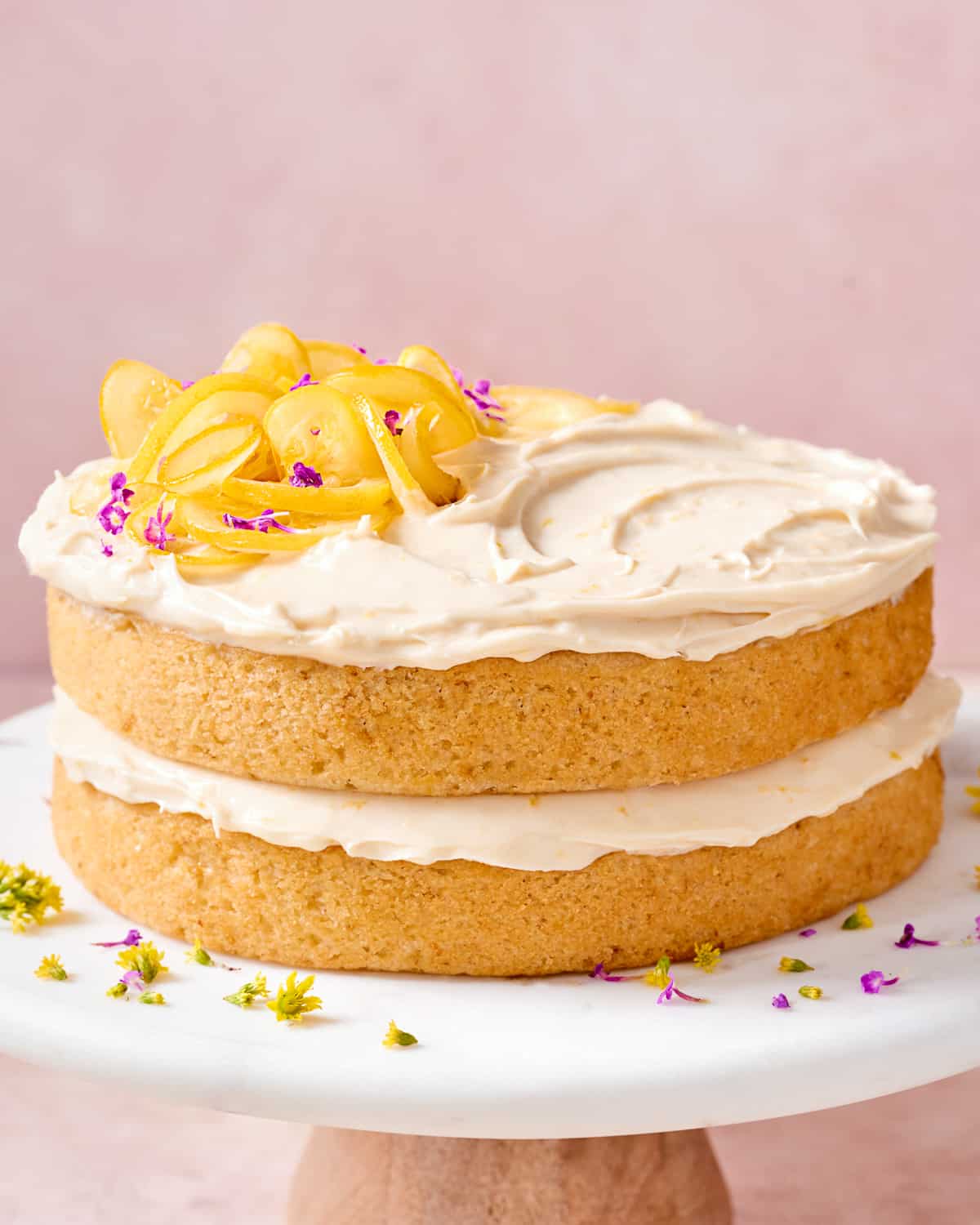
Frequently asked questions
Aquafaba is one of the primary methods for getting this cake so tender and light, so you won’t get the same results using a different egg substitute.
In one of our tests, we tried making the cake without aquafaba and we noticed a change in texture for the worse. It wasn’t inedible or anything, but the aquafaba definitely improves the texture.
We have not been able to test this cake gluten-free yet, so we can’t say what the end results would be.
We have noticed fairly different end results in other baking recipes when we use another type of milk since oats, nuts, soy, etc. are different ingredients with varying fat/protein/sugar contents.
We recommend sticking with oat milk if you can. We typically buy Califia or Oatly but any oat milk should be fine, as long as it’s not a “low-fat” variety. If not, soy milk will probably work fine.
Before serving, remove the cake from the fridge and set at room temp for at least 30 minutes. This allows for the best texture and flavor! Refrigerated cake is good, but room-temperature cake is GREAT.
As for decoration, it’s perfect with just the lemon cream cheese frosting, but some fresh raspberries on top are also lovely. We made candied lemons to make this cake extra pretty, though there’s plenty of lemon flavor in this cake to not need it.
Here’s a guide on how to make candied lemons.
You can store the unfrosted cake in an airtight container or wrapped in plastic on the countertop for 3 to 4 days. Once it’s been frosted, this cake needs to be refrigerated because there’s cream cheese in the icing. The cake should be eaten within 4-5 days.
YES! This makes a generous amount of cake (a two-layer cake), but luckily it freezes pretty perfectly, even when frosted. Individual slices will thaw most quickly and can be thawed on the countertop for 1-2 hours. Larger pieces of cake should be thawed in the fridge.
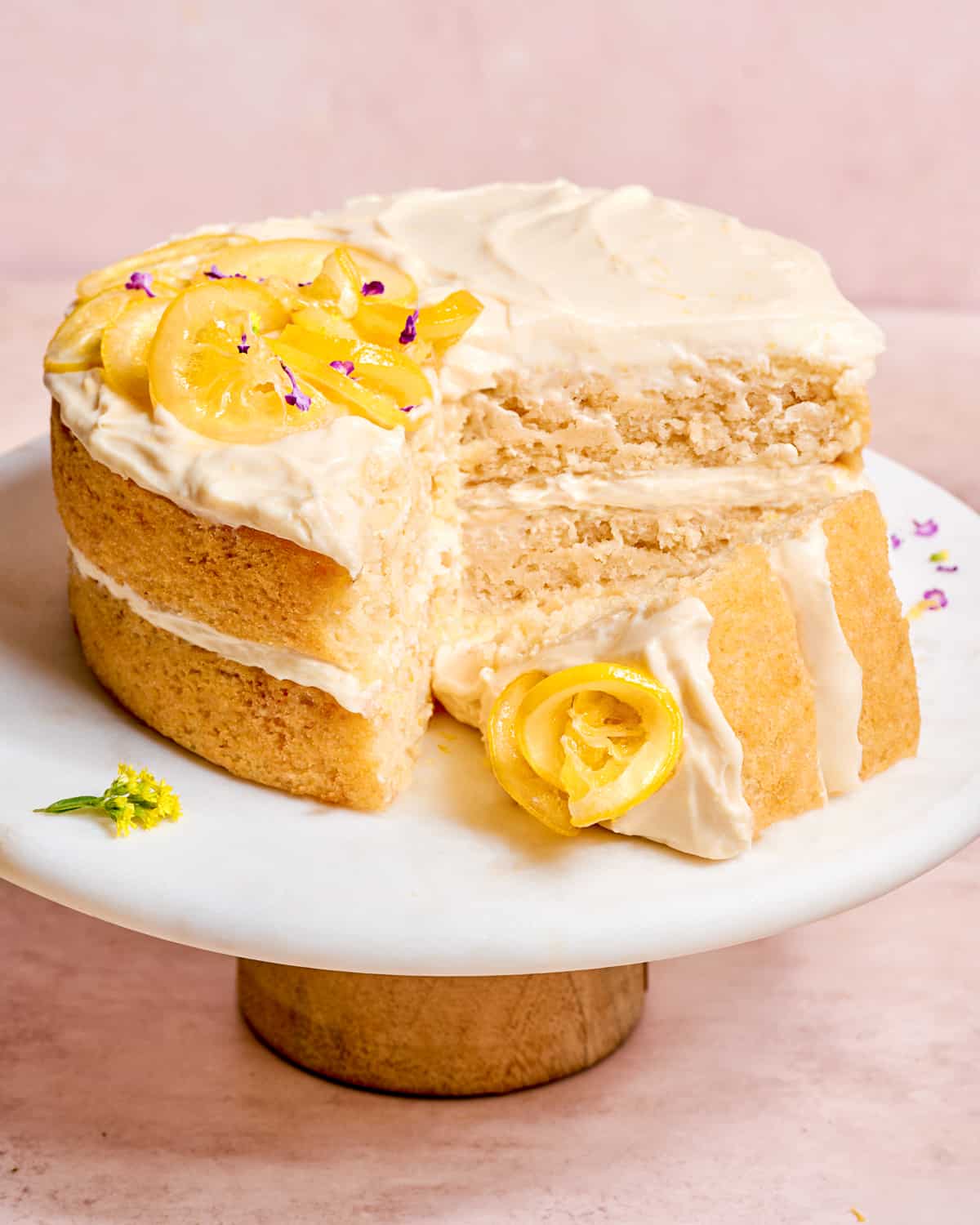
More Special Occasion Vegan Desserts
Video: How to Make Lemon Cake

Big Vegan Flavor
Techniques and 150 recipes to master vegan cooking.
Incredible Vegan Lemon Cake
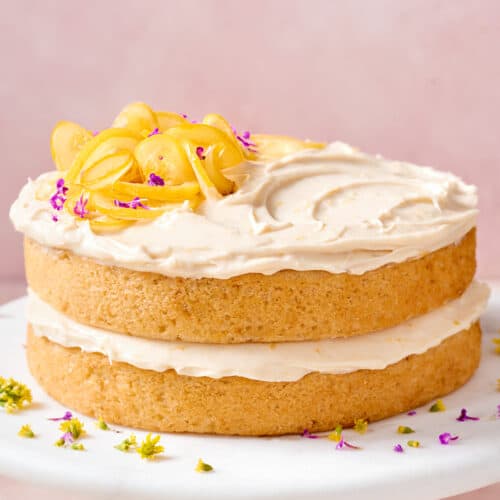
Ingredients
- 1 stick (8 tablespoons / 112g) vegan butter, softened at room temperature
- ½ cup (112g) vegan sour cream, at room temperature (see Note 1)
- ¾ cup (180 mL) oat milk, at room temperature
- 3 ½ cups (440g) all-purpose flour, spooned and leveled (or measured with a scale)
- ¾ teaspoon baking soda
- 2 teaspoons baking powder
- ½ teaspoon fine sea salt
- 3 large lemons, zested (3 tablespoons lemon zest)
- 1 ⅓ cups (280g) organic cane sugar
- ½ cup (120 mL) aquafaba (the liquid from a can of chickpeas)
- ½ cup (112g) neutral-flavored oil, such as sunflower oil
- 1 tablespoon pure vanilla extract
- Fresh berries of choice, or candied lemons for decorating (optional)
Vegan Lemon Cream Cheese Frosting
- 1 stick (8 tablespoons / 112g) vegan butter, softened at room temperature
- 8 ounces (227g) vegan cream cheese, softened at room temperature
- 2 1/4 cups (270g) organic powdered sugar, sifted
- 1 teaspoon pure vanilla extract
- 1/8 teaspoon fine sea salt
- 2 tablespoons lemon zest
Instructions
- Take the butter, sour cream, and milk out of the fridge. Slice the butter into small cubes to soften quickly (see Note 2). Measure out the milk and sour cream instead of leaving them in their containers so they come to room temp more quickly.
- Arrange a rack in the middle of your oven and preheat to 350°F/175°C. Make two parchment paper rounds for two 8-inch (20 x 5 cm) round pans. Grease the bottoms of the pan with nonstick spray, then line with the parchment papers. Now spray the parchment paper round and coat the pan’s sides with nonstick spray.
- In a medium bowl, combine the flour, baking soda, baking powder, and salt. Whisk very well to evenly combine the leaveners.
- Over a large bowl, zest the 3 large lemons.
- Now stand the 3 lemons upright on a cutting board. Cut the ends off of the lemons and use a sharp knife to peel away the peel and white pith right underneath, and discard. Use your hands to peel the lemons into segments, like you would oranges. Peel away the fibrous membrane on the outside of each lemon segment. You should now be able to easily pull the lemon flesh out. Mince the lemon into tiny pieces, picking out any seeds.
- Put a strainer or sieve over a small bowl and pour the lemon pieces with accumulated juices over the strainer (do not press the lemons down to release more juice). Measure out about 70g lemon pieces (5 TBSP) and 45 mL (3 TBSP) lemon juice from the bowl. Save leftover juice for a lemon water or spritzer–don't add extra juice to the cake.
- Add the sugar to the lemon zest and rub together with your hands to release the zest’s essential oils. Now add in the softened butter and oil. Beat on low with the mixer, and once the butter is in small pieces, increase to medium . Beat until starting to get fluffy and shiny, about 1 minute total. Rinse and dry the beaters for the next step.
- Shake the can of chickpeas to disperse the starches. Pour ½ cup (120 mL) aquafaba into a small bowl. With an electric mixer (or stand mixer), beat on medium speed until the entire mixture is foamy, including at the bottom of the bowl, 1 to 1 1/2 minutes.
- To the lemon zest-sugar-butter mixture, add the whipped aquafaba, room temp milk and sour cream, and vanilla. Mix on low until just combined, 15 to 20 seconds. Finally, add the lemon pieces (if any juice has accumulated, drain it off) and the 3 tablespoons lemon juice and mix again until well combined.
- Note: before combining the dry and wet ingredients, make sure everything else is ready (oven is preheated, cake pans are prepared). This is because the baking soda will start to leaven as soon as it's mixed with the wet ingredients. Add half of the flour mix into the liquid mix, beating on low until just combined. Add the remaining flour mixture and mix just until you have a mostly smooth batter, then stop. If it gets too tough with a mixer, switch to a silicone spatula. Now use a silicone spatula to fold the bottom and sides of the bowl with the spatula to ensure it’s well combined. If the liquid has settled on the top, fold the batter a couple times to incorporate. The batter should be thick and fluffy but airy.
- Use a digital scale (or measuring cups) to evenly divide the batter between each cake pan (~ 750g / 26 oz per cake pan). Smooth out the surface with the spatula or an offset spatula.
- Bake for 33 to 35 minutes, or until the centers are set and the cakes have puffed up a bit and just started to pull away from the pans. A toothpick inserted in the center should come out clean or with a few moist crumbs but not liquid batter.
- Cool the pans on a wire rack (don't rest on the counter) for 30 minutes. Now add a sheet of parchment paper to the rack. Carefully invert the cakes onto the rack. Cool completely before assembling, ideally in the fridge for a bit to set.
- Make the Lemon Cream Cheese Frosting (or make it 1-3 days ahead of time and refrigerate). Sift the powdered sugar in a fine mesh sieve. Add the softened butter to a medium or large bowl. Using an electric mixer, beat on medium speed until smooth. Add the cream cheese and beat just until well-incorporated. Add half of the sugar and beat on low to combine. Add the remaining sugar and mix again until well-combined and fluffy, scraping down the sides with a spatula. Add the vanilla, salt, and lemon zest, and mix until smooth. If the frosting is a bit loose, refrigerate the frosting before icing the cake.
- Assemble. Place one cake (bottom side facing up) on a cake platter or large plate. Add a generous layer of Lemon Cream Cheese Frosting on top (ideally refrigerated for easier spreading), spreading to the edges using an offset or icing spatula. Top with the second cake (top side facing up). Add another layer of frosting on top and spread out. If you have leftover frosting, you can frost the sides of the cake, using the spatula or bench scraper to smooth it out. If you want less frosting, leave as is. Decorate with berries or candied lemons, if desired.
Notes
- Time doesn’t include cake cooling/chilling time.
- I recommend refrigerating the frosting. It will thicken, making it easier to frost the cake.
Recipe: Nisha Vora / Rainbow Plant Life | Photography: Megan Morello





I made this for my mom’s birthday and it was divine! Like, are you kidding me? I’ve tried making some vegan cakes in the past with mild success but this was so great and so lemony, which was perfect for my mom, the lemon lover, and me, who might prefer vanilla but still had way too many slices because it was so good.
I had a few helpful/”don’t make the same mistakes I did” tips:
ABSOLUTELY use a kitchen scale. I bought one a year ago and all of my baking recipes have improved tenfold and they’re consistent. You can get a cheap $10+ one at Wal-Mart and it is so worth it.
You’ll want to start making this so much earlier than you’d think. I’d recommend doing it a day before since you’d get a lot more cooling time. It took me a long time with all the moving parts.
I added the zest of another lemon in the cake since my lemon zester was bad and did not really give enough zest. I just used the extra lemon for lemonade, not for the cake. That meant I forgot to save lemon zest for the frosting, but even with a vanilla cream cheese frosting, the cake was still so lemony, so that wasn’t overpowered.
If a knife/toothpick comes out clean but the cake isn’t golden on top, take it out anyway. I added a few more minutes to get a little golden, but it made the top a little drier than the rest of the moist cake, which wasn’t too bad, but I probably could’ve gone without those extra minutes. It might have also benefitted from leveling a bit, so if you add those extra minutes anyway, leveling might resolve the issue.
The cakes wanted to fall apart a bit when transferring to the cooling rack out of the pans, so caution is advised. Cooling in the fridge helped so much to keep it together and icing the cake was no issue.
You might also benefit from using a simple syrup to douse the cakes and keep them moist if you refrigerate them, especially if making a day ahead. They stayed moist without it, but I only kept them in the fridge for a couple of hours.
If you’ve got a dishwasher, empty it before making it if the idea of that many dishes sort of seems unappealing when making this recipe. When everything was in the oven, I made my frosting and then everything went into the dishwasher no problem.
All in all, a fantastic cake that was fitting for my fantastic mom :)
Hi Lilla, thanks for the thoughtful review! We appreciate it, and are thrilled you are such a fan of the cake!
Followed the instructions to a tee, and the first cake immediately fell apart when I tried to transfer it off the wire rack. Pieces Tasted great, but falls apart way too easily and completely wasted 2 hours of effort.
Hi Ray, to help troubleshoot, can we ask if the cake was cooked through once it was done cooling?
And did you use measuring cups or a digital scale to measure the ingredients? (I always recommend measuring in grams and milliliters using a scale because it’s far more accurate than measuring cups—not all measuring cups are the same and everyone measures differently, and in baking, small changes can make a difference). For instance, too much moisture from mismeasuring liquid ingredients could cause the cake to fall apart.
Also, did you test the cake for doneness with a toothpick? This ensures the cake is fully baked through and shouldn’t fall apart.
Honestly had high hopes for this cake and it tasted decent but not worth spending 3 hours in the kitchen, following several tedious steps, needing multiple mixing bowls, then washing a sink full of dishes. Your simpler dessert recipes have sufficed and I will be sticking with that. Thanks anyway.
Hi Sierra, we’re sorry the recipe didn’t live up to your expectations. We hope you continue enjoying the other RPL recipes in the future!
My son and his partner made me this cake for my 60th birthday, which made me very happy indeed! I asked for the recipe, and now I am touched they went to so much trouble, a real special occasion cake.
So sweet, Jo! Happy belated birthday- we’re delighted to hear you enjoyed the cake :)
It pains me to write this review, as I’m usually a big fan of whatever I make from this website. This cake was an uncharacteristic disappointment. First, the texture: I’ll preface this portion by saying I’m an experienced home baker, so I know to weigh my ingredients, use the freshest leavening agents, not overmix, and have everything at room temperature. Despite doing all this, the cake was dense and heavy. I love a dense cake, like a coffee or pound cake, but instead of being the pillowy and moist crumb that a fork just sinks through, this crumb tended to break apart into larger clumps and had a somewhat grainy mouthfeel. Second, the taste: I know that many lemon cakes rely on a cake soak, frosting, or glaze for their fresh lemon flavor, as the zip of zest usually doesn’t hold up in the oven; I was hoping for a strong lemon punch in this cake itself, however, because of the new-to-me inclusion of the lemon flesh. I went through the rather tedious (and it is SO tedious) process of peeling and separating the lemon flesh, hoping that the cake crumb would be bright and zippy without needing any flavor assistance from the frosting. The end product, which is really not surprising considering the miniscule amount of fresh lemon (minus the zest) in the actual cake, was more like a lemon-scented vanilla cake. This didn’t really matter once paired with the frosting, which had plenty of fresh zest to help out, but I felt a little tricked by the promise of punchy lemon flavor in the cake batter. Maybe someone else will have better luck with this than I did, but I found that this was a lot of work (peeling lemons, whipping aquafaba) for little payoff. This cake is not by any stretch bad — guests at a garden party would be quite happy with this as a dessert — but it failed to live up to the hype. I understand that Nisha worked really hard on developing this recipe, so I feel like kind of an *** for posting this, but I don’t think there’s any getting around the fact that food blogs are a weird place…both highly personal and out there for everyone. The blueberry muffins, though? Make them. I ate 4 in one day. The lemon zest in the walnut crumble is divine!
The only thing I’m thinking could have happened is that the cake “compressed itself” somewhat over the course of the two days it had in the fridge before it was frosted and served. I had it wrapped tightly in saran wrap, so I don’t think it got any drier, but maybe what happened is that the structure got a little condensed from its own weight, especially with only aquafaba as an egg substitute.
Fantastic recipe thank you Nisha! Made it for my Book club ladies (none of whom are vegan) and they all LOVED it!! So good.
Hi Carla, thank you so much for your kind review!
Wonderfully lemony! And so moist and tender. It was fantastic. Made it for my mom’s birthday this weekend and she was so pleased (lemon cake is her favorite). Now my daughter has requested this cake for her birthday too!
How sweet to hear you’ll be making this cake for multiple generations, Bretta! :) I need to make this one myself asap- it sounds too good!
What a dream cake. This hit all the different buckets for me. Fluffy, moist, super lemony, sweet but not too sweet. I could go on but I ran out of adjectives. 5 stars!
Your review made our day, Michaela! Thank you for taking the time to share your thoughts and for trying out the recipe.
I followed this recipe to the letter! The cake tasted extremely good, however, it was heavy and dense. One of the layers broke when I assembled the cake, I think because it was so heavy. The cream cheese frosting was a complete disaster, so much so that I thought I had misread the recipe… I had not. The frosting was too thin and the cake just drank it up! The cake was definitely a 10/10 for flavour but scored less for texture. The frosting did not work out at all and I would have to experiment with other recipes.
From our recipe tester, Hannah: “Hi, this makes me sad, because this is the best cake I’ve ever had the pleasure of making! This recipe is one that you should read through entirely, with all the tips and tricks Nisha provides! I think a few things will change your outcome next time. It’s very important that you measure out exactly the amount of lemon juice and lemon piecs this recipe calls for, because it will quickly turn into a heavy and dense cake if too much is added (using a digital scale is the best). I highly recommend refrigerating the cake until it’s chilled, and same with the frosting. It makes it much easier and less messy to frost the cake when both are chilled. If your icing ingredients were too warm, and you applied it to a slightly warm cake, it’s definitely going to get messy. I hope you make this again, because it is the BEST cake!”
Can you make this gluten free as well?
Hi Cindy, we have not been able to test this cake gluten-free yet, so we can’t say what the end results would be. Sorry! :/
I made this for Mother’s Day, and it was a hit. Peeling the papery skin off the lemon pieces was a little time-consuming but totally worth it, and the frosting was delicious. Thanks again for another great recipe!
Paula, Thank you for your thoughtful review! We’re so happy to hear that everyone enjoyed the cake.
My son made this today for my birthday and found it pretty near impossible to follow the directions for separating the flesh of the lemons from the skin. It took him almost three hours to make the cake and frosting. He has made cake quite a few times over the years and is known for them, very careful at measuring etc. The results tasted good but were heavy and gooey. (I have had similar results over the years with various recipes and don’t know why. Thought it might be because I don’t measure very exactly. Do you know why this happens?)
Hi Liz, I had our recipe tester Hannah answer this one! Sorry for the late reply.
“Hi – after making this recipe more than 10x at RPL kitchen, I’m almost 100% positive that you used too many lemon pieces and/or lemon juice. We tested several variations of this cake and our biggest obstacle in the recipe development process was whenever we used more lemon juice or lemon pieces, it ended up too dense.
However, when we scaled back on the amount of lemon pieces/juice we used, this changed the cake’s texture into a beautiful tender crumb cake. We hope you give this recipe a try again, it’s my favorite cake of all time!”
This is delicious!!! Thank you Nisha. U R the best.
Hi Leah, Thank you so much for such a fantastic review! Appreciate you taking the time!
Absolutely divine cake!! I made this for a friend’s birthday and it was a big hit!
I used 420g of king Arthur’s cake flour, substituted the sugar in the cake with 94g date sugar and 186g coconut sugar, Violife sour cream, and Trader Joe’s vegan cream cheese and made a mixed berry compote filling!
That icing though…. really took the cake 😉
Thank you so much for sharing this recipe!!
Thanks for sharing your experience, Gina! We’re thrilled to hear the cake was a smashing success :)
Has any tried this in a bundt pan?
Hi Beth! This is a recipe that we tested so many times before we perfected it, it was a long lemon-y journey! I don’t think a Bundt pan would work, but you are more than welcome to try. I think this lemon cake batter needs to be divided between two pans because they are stubborn and they need to breathe and have their space. I think if you pile all the batter in a Bundt pan, you’ll have an overly moist, potentially soggy, lemon cake. If you do decide to test it, you’ll probably need to bake it at least 10 minutes longer, maybe even 30 minutes. Please let us know if it’s a success, we’d love to hear it!
I made the lemon cake for my boyfriend’s daughter’s 21 birthday, and it was a HIT. OMG, it was the most delicious lemony cake I’ve EVER had. I am NOT a baker, so I was a bit nervous to try this, but it was a huge success. SO delicious!
Your review made our day, Martha! Thank you for taking the time to share your thoughts and for trying out the recipe.
This is the 5 vegan lemon cake recipe I’ve made and by far the best. As a vegan baker, i have been looking for a fluffy and lemony cake recipe for so long. I’m so glad I gave this one a try. I didn’t follow the recipe exactly though. I put all the wet ingredients in my mixer (including the liquid aquafaba). I also used coconut yogurt I stead of sour cream. I mixed that up and then added the dry ingredients. It was simple and easy.
Thanks for sharing, Sarah! So happy you loved it :)
Would u be able to share how much vegan yogurt u’ve used and the brand if the yogurt? As some branda are very thick and some quite thin.
It took a lot of time to make but was totally worth it! I got a lot of compliments. Two things I’ll do differently next time – I’ll use more stable butter for the cream, it’s was completely runny. And I will make half of the recipe. two-tiered cake is quite unnecessary and just takes a lot of work I had to bring it to the office because there was a lot left.
But With all that – this is one of the most successful cakes I’ve made since becoming vegan (And it’s really important to follow the instructions)
Hi Ainat, thanks for taking the time to leave a review. It’s great to hear the cake was well-loved :)
This lemon cake is so, so, so good! I always struggle to find good vegan desserts, but this one knocked it out of the park! The lemon flavor is perfect and it doesn’t taste like a typical vegan dessert. My omnivore relatives loved it too! 10/10
Your review made our day, Stephanie! Thank you for taking the time to share your thoughts and for trying out the recipe.
Hi! I’m considering baking this cake for my 40th birthday this weekend. I’ve never baked it before so it is a little risky but it sounds so good I might go for it! I need it to feed about 20-25 people. Should I bake two full cakes? Or how could I adapt the recipe to make it larger? I know this is super short notice but any advice would be greatly welcome!
Hi Raquel, you could certainly double the recipe and bake two layer cakes, but you could also 1.5x this recipe so you wouldn’t have as much to bake. It depends on how big of slices you expect guests to eat (with doubling the recipe, everyone gets a generous portion; if you 1.5x the recipe, everyone gets a small but not tiny slice).
For instance, you could 1.5x the cake ingredients and bake each cake pan separately. Then make 1.5x the frosting. Then you can frost each cake separately and serve them as three single layer cakes instead of double layer cakes. Obviously, the presentation will be different but it’s a slightly easier option.
If that interests you, when you click the “print” button on the recipe card, there’s an option for you to adjust the serving size. If you go up to 24 servings, the recipe will automatically 1.5x the recipe for you.
I made this cake today & will let it sit overnight in the fridge.. I’m excited to try it tomorrow! Only issue I had was my frosting separated :( I’m wondering if I let me butter become too warm before mixing? Or what else could I have done to avoid this? Also, is there any trick to make it look smooth & creamy once separated? I used Miyokos brand butter & Simply Truth brand dairy free cream cheese.
Hi Sarah, I think your butter may be too warm. Room temperature cakes are annoyingly difficult to frost, so I recommend chilling the baked cakes and the lemon frosting simultaneously (at least 1 to 2 hours, or longer).This makes it much easier to ice the cake and prevents your cake from becoming crumbly. It also firms up the cream cheese frosting, allowing an easier spread.